Life goes wondrous circles sometimes. It was back during my Atlantic Ocean voyage from Lisbon to Lanzarote when after another early and frosty watch my skipper told me, that a friend of him is going to build the Omega 42 sailing yacht. At this time, I must admit, I didn´t knew what the term “Omega 42” really meant but after one hour of excessive and enthusiastic swarming by the skipper I began to read into this topic and – hell yeah – I instantly understood my skipper´s wet eyes. Now, some 10 months later I was finally able to pay a visit to the very workshop, where this legendary yacht is reborn.
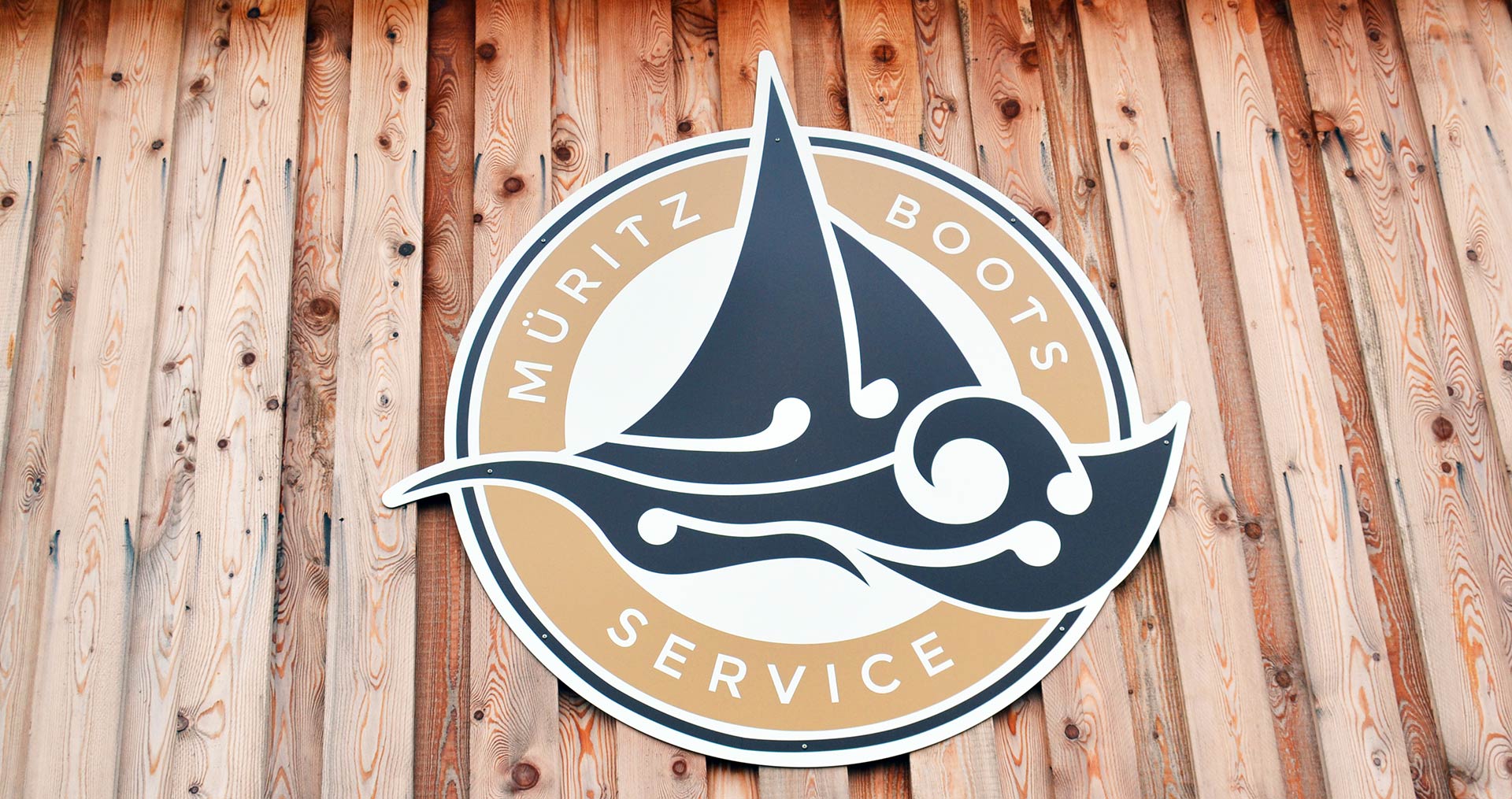
Waren, a small and nice town at the lake of Mueritz, is situated right in the heart of the Mecklenburg-West Pommeranian lake land. A thin populated, hilly, green and lush strip of land, bristling with a thousand lakes, deep forests and small villages. Agriculture and tourism of the nearby Baltic shore with its endless perfect sandy beaches is the main character of this state of Germany. After a two hours drive I park the car in front of a brand new built workshop: Müritz Boots Service, says the sign. And Heiner Francke, the boss of this yard, welcomes me cordially with a strong handshake.
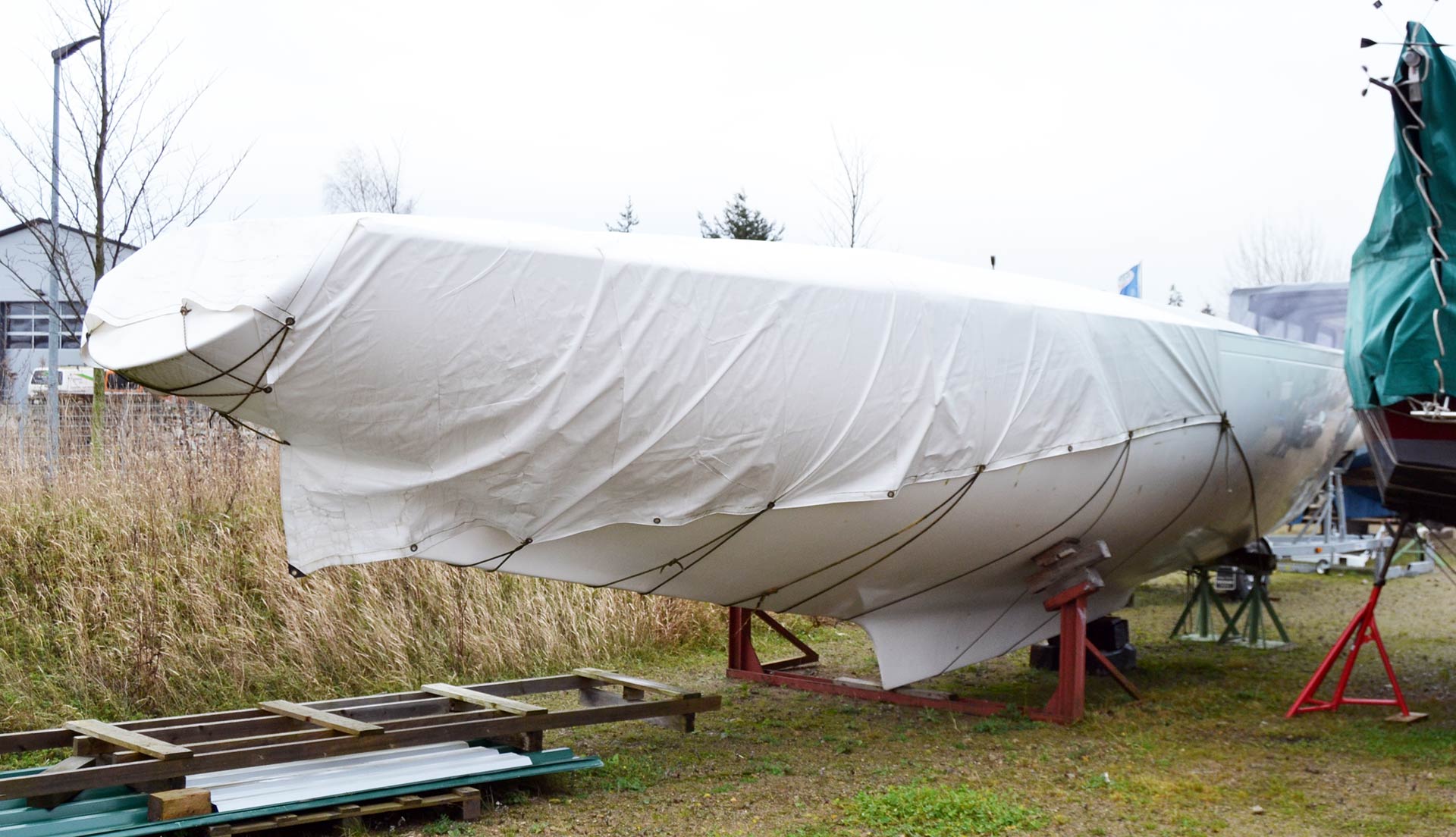
I don´t have time to marvel the hull of the Omega 42 that is parked outside the yard, half wrapped, because Heiner takes me instantly to his bureau, across the workshop where the people are working, upstairs. Offering a cup of coffee, sitting down and expressing a bright smile: I can see, that he is as enthused as I am. And seemingly very proud to show me the work of his yard. I am the first journalist to visit him here and that´s a premiere for both of us. Let´s dive into the history of this sailing yacht and the story behind her being re-born.
“Like a wink by Poseidon himself.”
We sit down in the bureau, Heiner offers a fresh cup of coffee. 15 years ago he decided to take the risk and found the small yard. The prospects of acquiring enough jobs were good: Lake Müritz is one of the biggest lakes of Germany – dozens of smaller sized sailing boats roam its waters, most of them being classic wooden boats. Since then the Müritz Boots Service, as he named his company, does very well. “We are able to employ 6 people”, says Heiner, seemingly proud – this state of Germany is not the most prosperous of them all. I ask how he got the idea to revive the Omega 42. “Oh”, he says, “that´s a kind of funny story.”
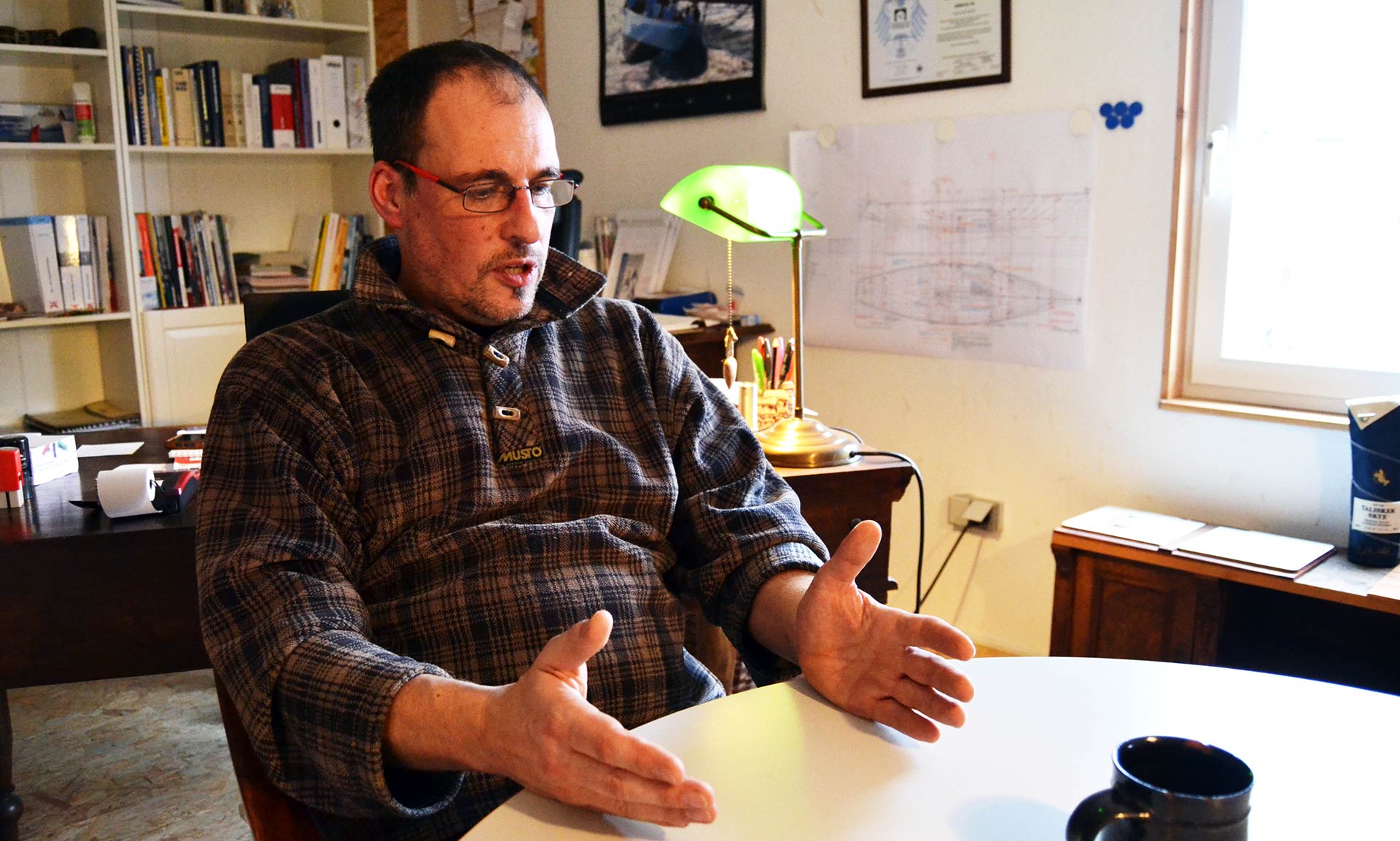
Some years ago, then out on the Baltic Sea participating in one of the numerous boat races, he and his crew returned from a day out with tension, sports and fun: “As we were sitting in the cockpit, enjoying the sunset and a cold beer, we fantasized about our personal dream yachts.”, Heiner tells me. “And about which yacht we would love to build.” When it was his turn to tell his mate the favourite yacht of his own, he said: “Well, folks. There is this one boat … so sleek, so neat, so unbelievably beautiful … it is called the Omega 42.” Heiner looks at me, bends over as he is going to tell a secret: “And believe me or not – right at this moment an Omega 42, the very boat I was talking about a minute ago, was entering harbour!” Jars hinged down, eyes grew big: “Like a wink by mighty Poseidon himself.” We laugh.
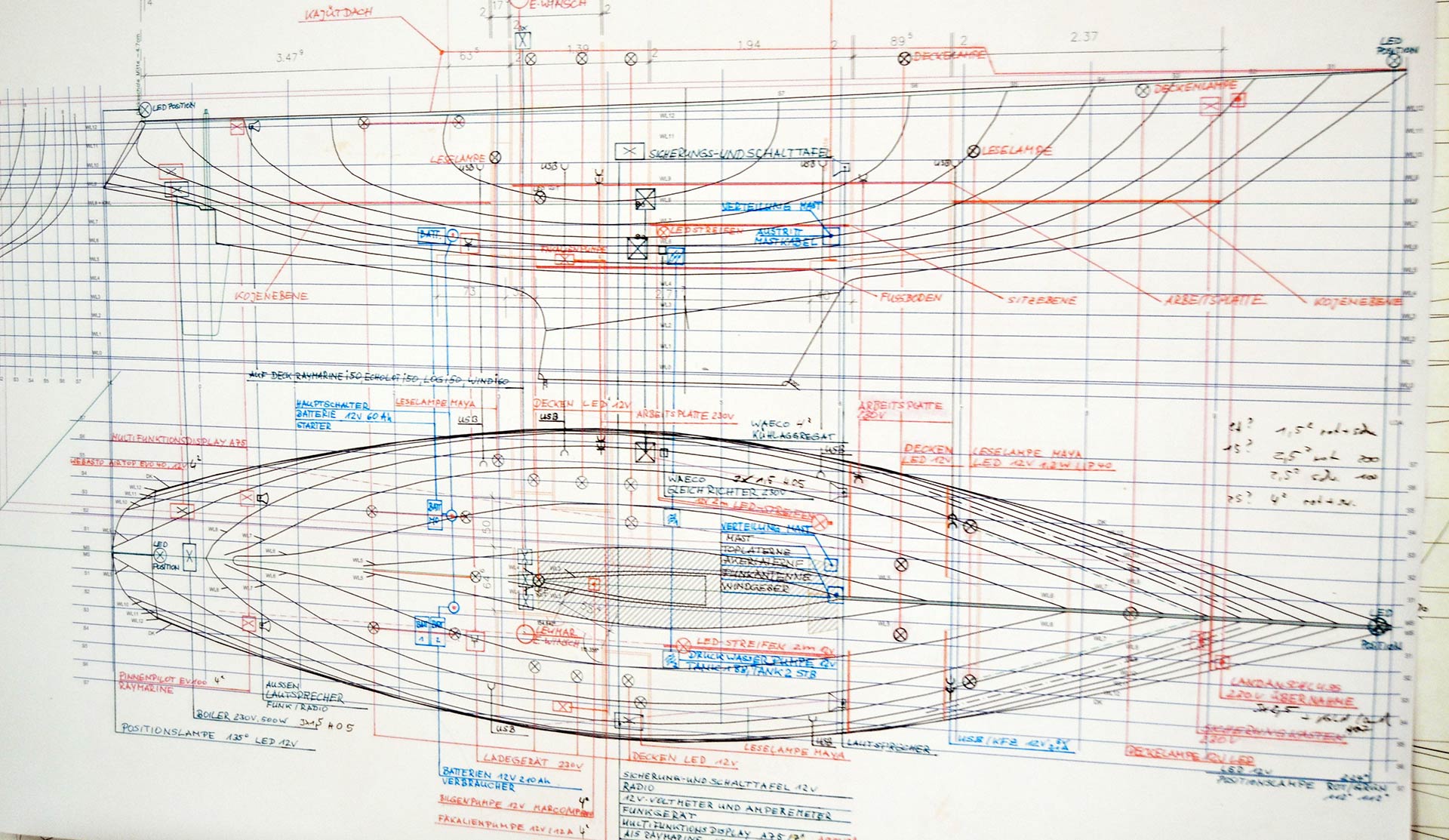
One of the mates sailing with him on this very day, Stefan Gossing, fell in love with the boat instantly. Heiner tells me: “Stefan looked at me and said – ´I am in!´ – and this was the day when the idea was born to build the Omega 42. Of course – we didn´t know anything about the fate of the originaly plans, the moulds and all that stuff.” A true odyssey and a tedious phase of research for the team began, sucking up time, money and, sadly, some enthusiasm. “It was impossible for us to get in touch with Peter Norlin´s family. But we finally managed to identify where the moulds ended up.” It was no less than SwedeStar, the very company better known as the manufacturer of Najad Yachts. “We drew hope again and gained confidence.” Contact was established very fast. “They´ve invited us to come and see the moulds – it seemed like they were also very interested in this project.”
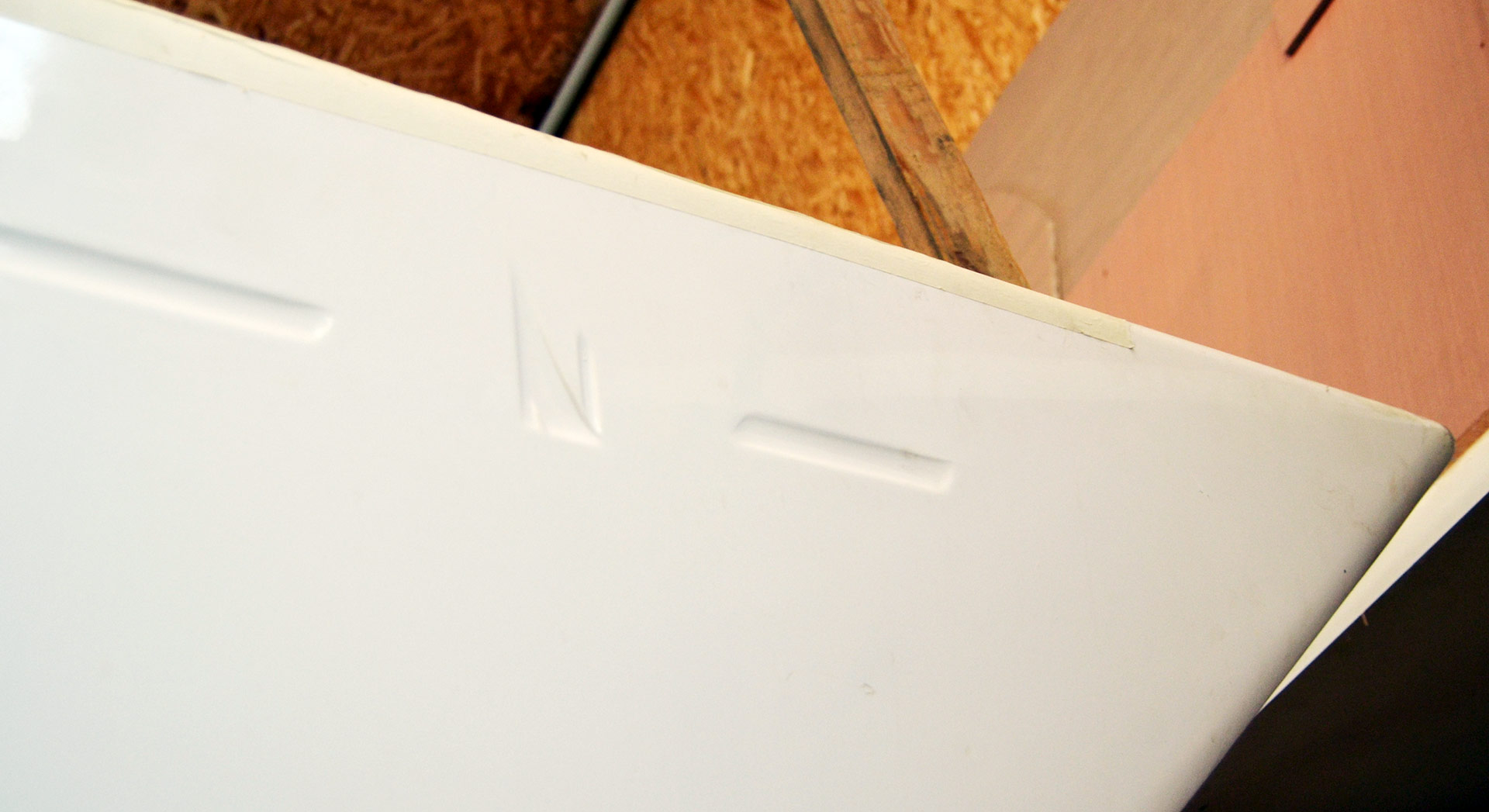
In the end, after weeks and months of negotiations, of planning, of costing the whole project out, they finally were able to strike a deal with the Swedish traditional company: “As it would have been way too costly for us to get the moulds to Germany, apart from the fact that I would have needed to establish a hall for laminating, we now get the hulls made by SwedeStar. Which of course is perfect for us and for the Omega 42 project”, Heiner explains. SwedeStar will manufacture the hulls in Sweden – readily laminated hull, deck superstructure and smaller GRP parts will be shipped to Germany and Heiner and his crew will do the complete interior fitting and final production of the boat. “They can of course provide an excellent quality in making those parts”, Heiner said, “and beside, it´s also best for the Swedish heritage of the Omega 42 that the very hull is actually still made in Sweden.” We raise from our stools and go down to the workshop.
The Antipode: OMEGA 42 Sailing Yacht
Hull #1 is jacked up and I instantly freeze in awe right under the sharp bow. The Omega 42 is an extreme in almost every aspect. She is the antipode of “modern” yacht building. Peter Norlin himself, the inventor of the chines said once, that the Omega 42 was his favourite boat of them all. The yacht is slim. Very, very slim: With a length over all of 12.94 metres she bears a width of just 3.10 metres. For comparison: My own boat, the King´s Cruiser 33 of the same era bears 3.12 width with a LoA of 10.26 metres! A modern day Beneteau 41.1 has a LoA of 12.43 metres and features a beam of 4.20 metres. Or, to translate it into abstract figures: The length/width-ratio of the Omega 42 is 4:1, a present day Beneteau´s is 2.9:1. “Length is running!”, says Heiner and behold, the Omega 42 is righteously dubbed the “Sweden-Express” as she used to be a damn fast boat indeed.
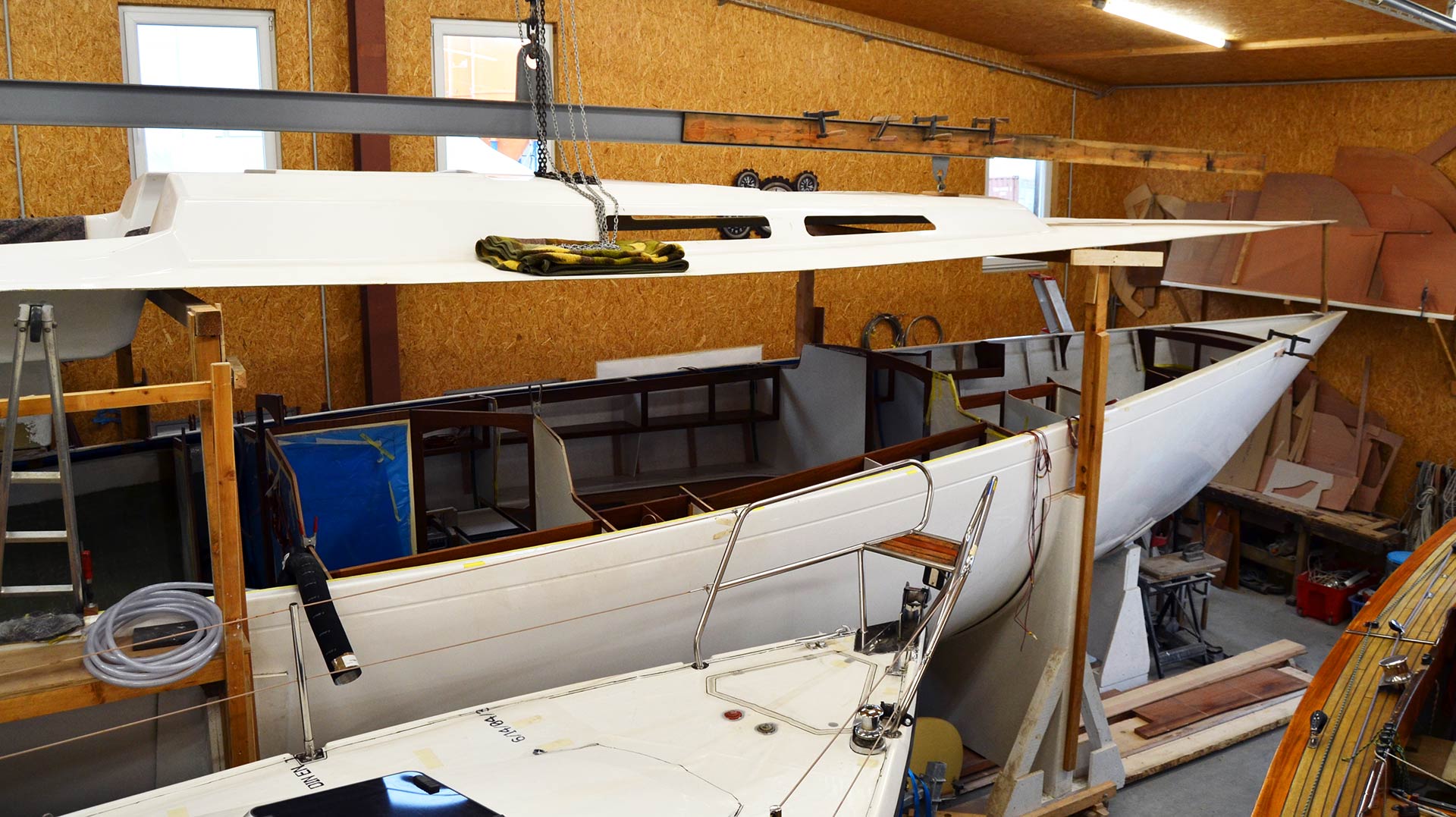
“There were no plans nor any drawings available”, Heiner tells me as we climb the ladders to reach deck level. “Fortunately, SwedeStar did have the lamination plans so that we could be sure that the structural integrity of the construction would meet the requirements. But anything else was simply not there anymore. Vanished over the decades.” Heiner searched and finally found the owner of the very last “original” built Omega 42 yachts: “This man was worth gold as he not just allowed us to sail the boat but to meticulously crawl each corner of the yacht and take measurements.” As Heiner is a skilled boat builder, he was then able to reconstruct all plans needed for the project. Like an archaeologist, he had to take hundreds of measurements and draw dozens of plans. “My aim is to re-create the real feel of the boat. Not just a similar looking yacht, a fake, but the real Omega 42 like Peter Norlin wanted her to be back then.”
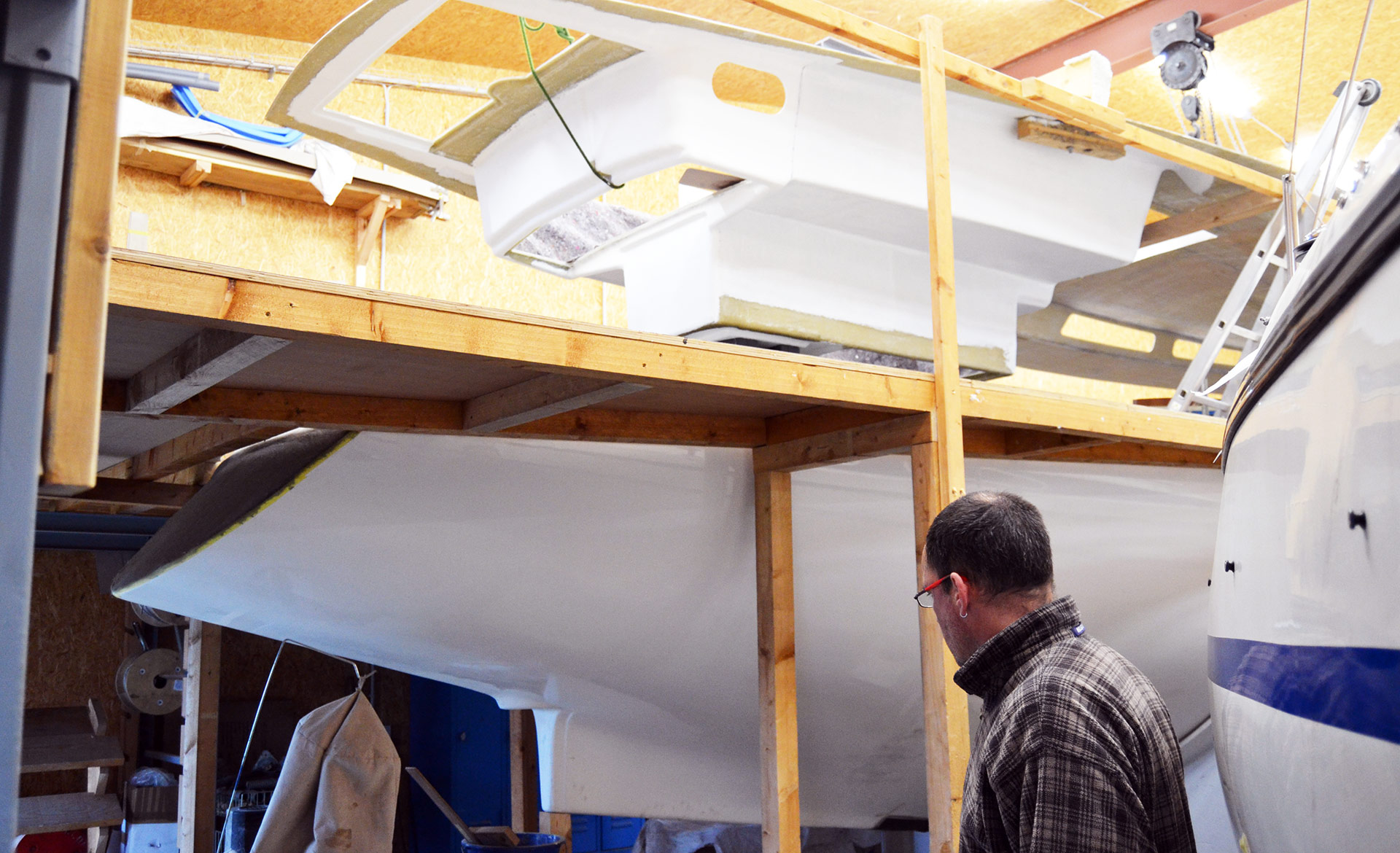
Norlin, creating the Omega 42 back in the days when IOR was ruling how yachts looked like in the Seventies, abstained from all the restrictions and limitations of IOR. The Omega 42 was – as he puts it himself – the ideal sailing yacht not following any class restrictions. That’s the sleek hull does not have the baggy “tea pot design” that is so signature of IOR-yachts. She does have large overhangs, of course, and a sharp bow to lengthen the waterline, but on the Omega 42 nothing is IOR. She was a revolution already back in her days. “As you can see – this yacht is the antipode of virtually everything en vogue in yacht building of today”, Heiner says and points to the yacht. I nod.
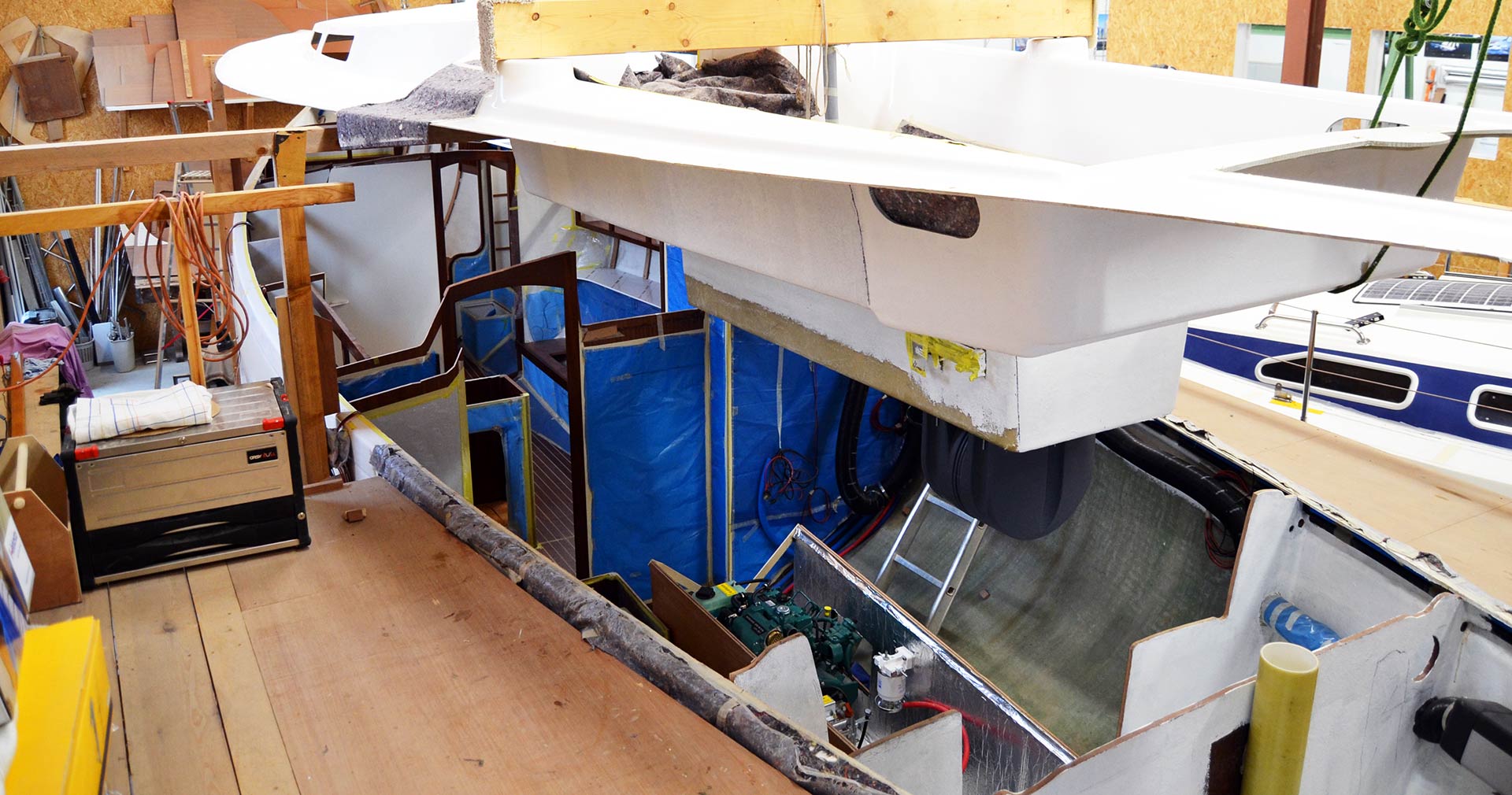
Wide sterns, hard chines, large volume, double aft cabins, double steering wheels and twin rudders – almost a “must have” in modern yachts. Nothing of this can at all be seen on an Omega 42. She is as sleek in the stern as she is sharp in the bow. Tiller steering, a necessity on a fast sailing, high powered yacht like this, is a matter of course. A slim quarter berth on port side (I figure it even slimmer than my own quarter berth, a slim saloon and even a slimmer fore cabin. Classic layout of the Seventies. “We of course kept the internal layout”, Heiner explains. “There aren´t too many concessions to 21st Century sailing.” Which concessions?, I ask.
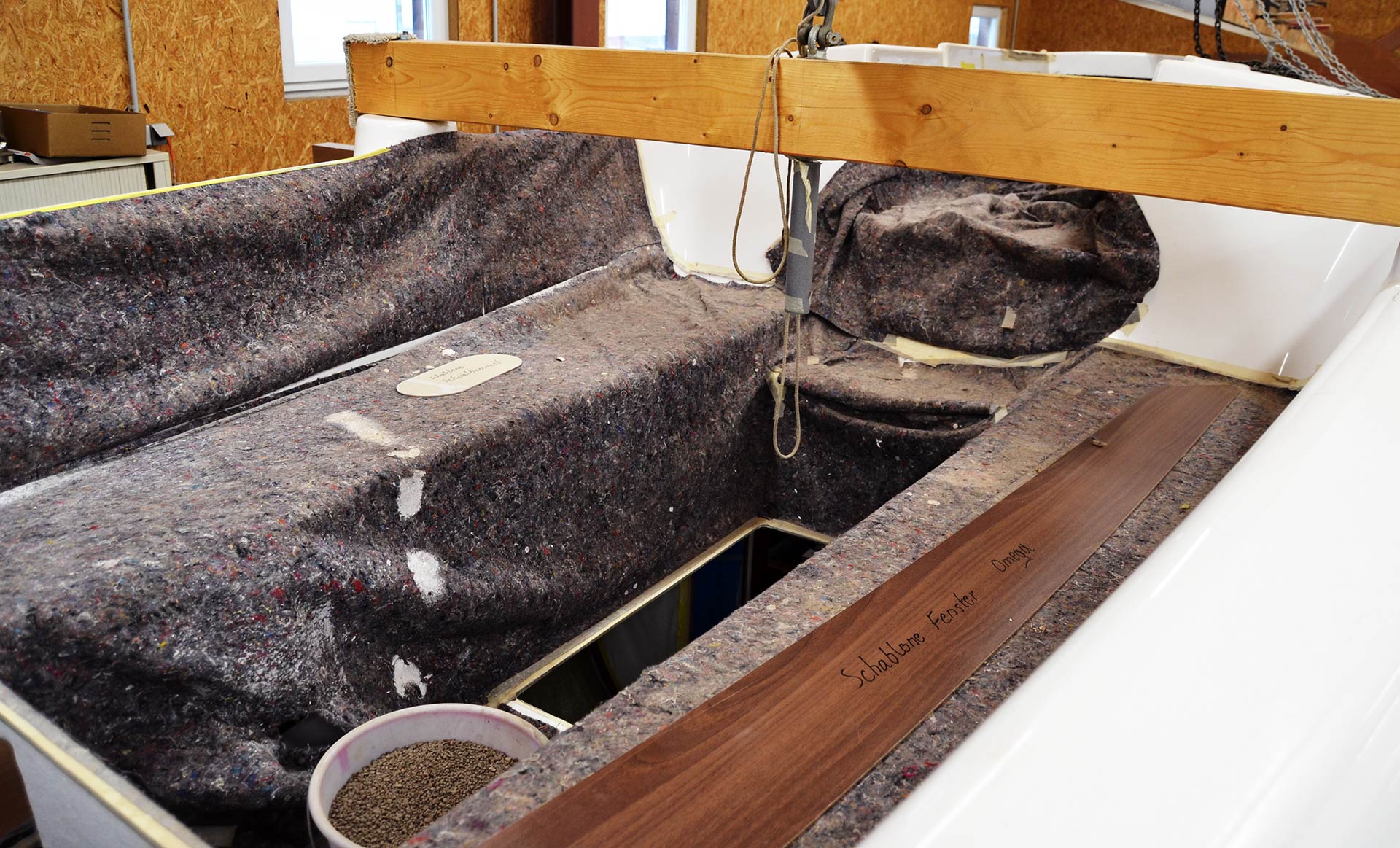
“Well, you see, the original Omega 42 was a bit overpowered, carried a load of canvas and too much of it in the mast top. The mast tended to break, partially also because of the fact that the original mast just had one spreader.” And because of the boat being that slim, the shrouds could not take too much loads.” So, in cooperation with Selden Masts the whole rig was completely re-designed. “Breaking masts won´t be a problem now”, Heiner smiles. Another concession: “I agreed to fit a chart plotter.” Heiner smiles. “And an electronic winch for the main halyard.” And I feel that this basically was it, when it comes to “modernize” the boat.
The “Sweden-Express” comes to Life again
As I get closer to the yacht and spend more time in looking at the details, I realize that this really is a boat from the past. Seeing this with the eyes of a modern-day sailor, lots of things appear unbelievable. But that´s also the freshness of this project: The Omega 42 does not have to make herself pretty and appealing to modern client´s eyes. She is what she is. And she is proud of it indeed. In the aft section, there are two large lockers for roping and fenders. The skeg-less rudder is fitted with two strong bearings. “On a yacht like this you simply need a tiller. It will transfer directly and instantly the flow of the water around the hull – this indicating potential for sail trim”, Heiner explains. You wouldn´t get this on steering-wheeled-yachts, he adds.
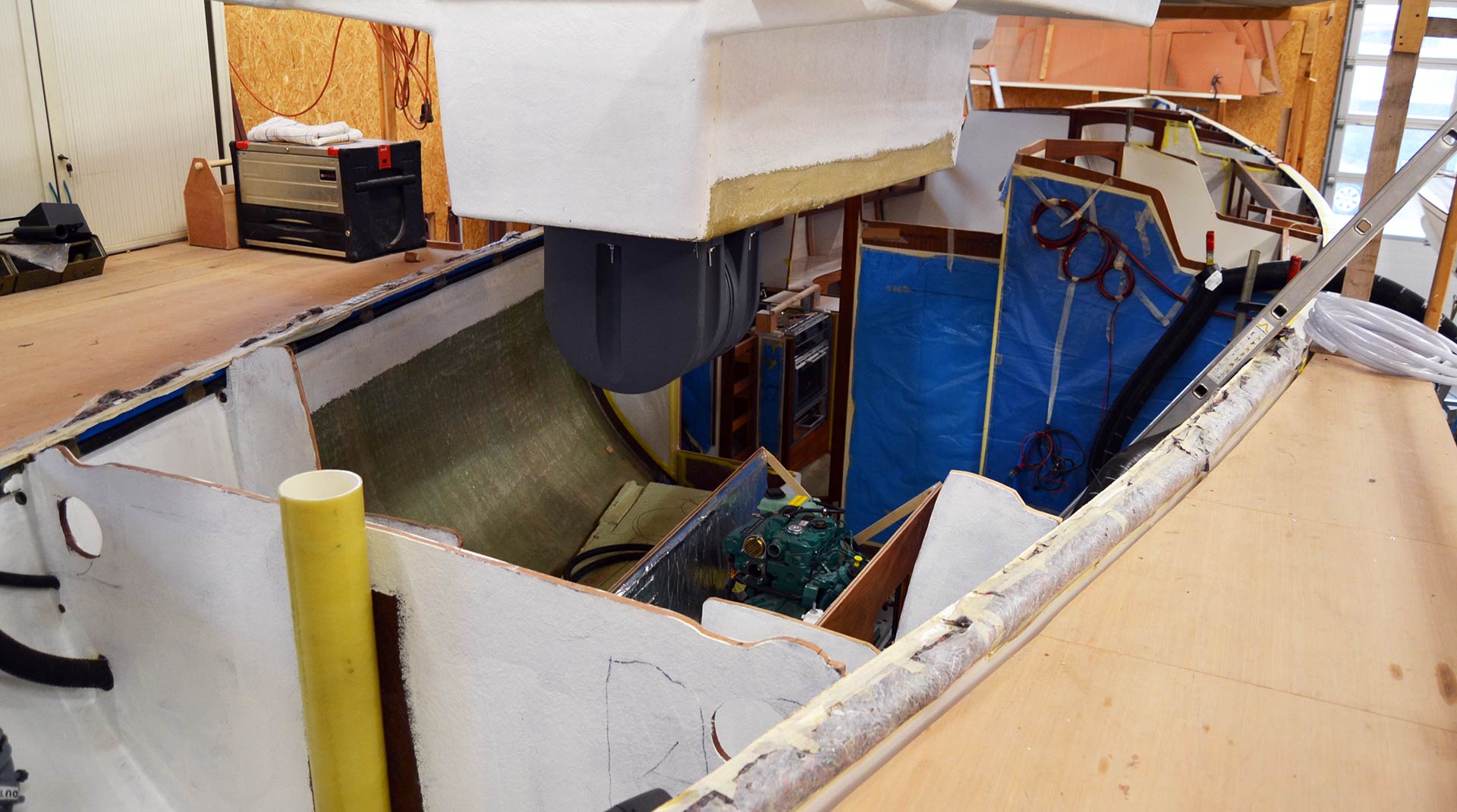
The is also very large storage “room” vis-à-vis from the quarter berth on starboard side. The sailor will reach it by crawling underneath the entryway. It will be big enough to house spare sails. “I will even fit a small worktop with a bar-clamp for the owner here.” The whole aft section is separated from the saloon by a door so that the quarter berth becomes a sort of cabin, which is really cool as this is a critique I do have for my own boat where the quarter berth is open to the saloon.
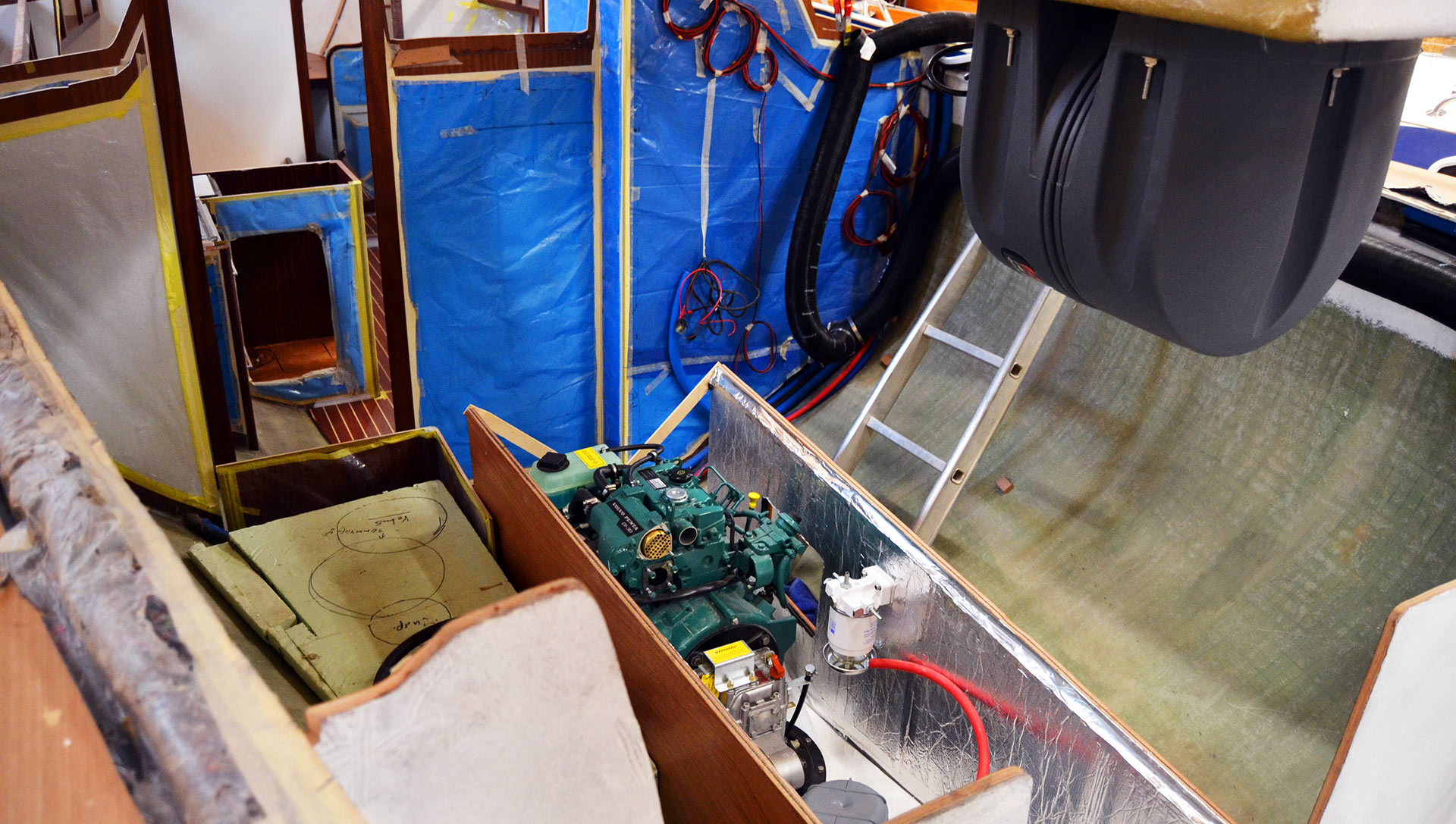
Also a concession to modern days is the fitting of a contemporary sail drive. There will be a 30 horse power Volvo-Penta Diesel engine where on the original Omega 42s a fixed shaft 20 hp Yanmar was mounted. I joke around: “Is there space for a bow thruster?”, Heiner answers with a grim face, but smiles: “Anything a new owner may want will be fitted, of course”, he says, “but if you ask me, nothing of it will make it onto the boat. As I said: I want to re-create the kind of uncompromising character of this yacht – to the bone.” It´s a boat for sailors, he mentions, as we climb into the hull.
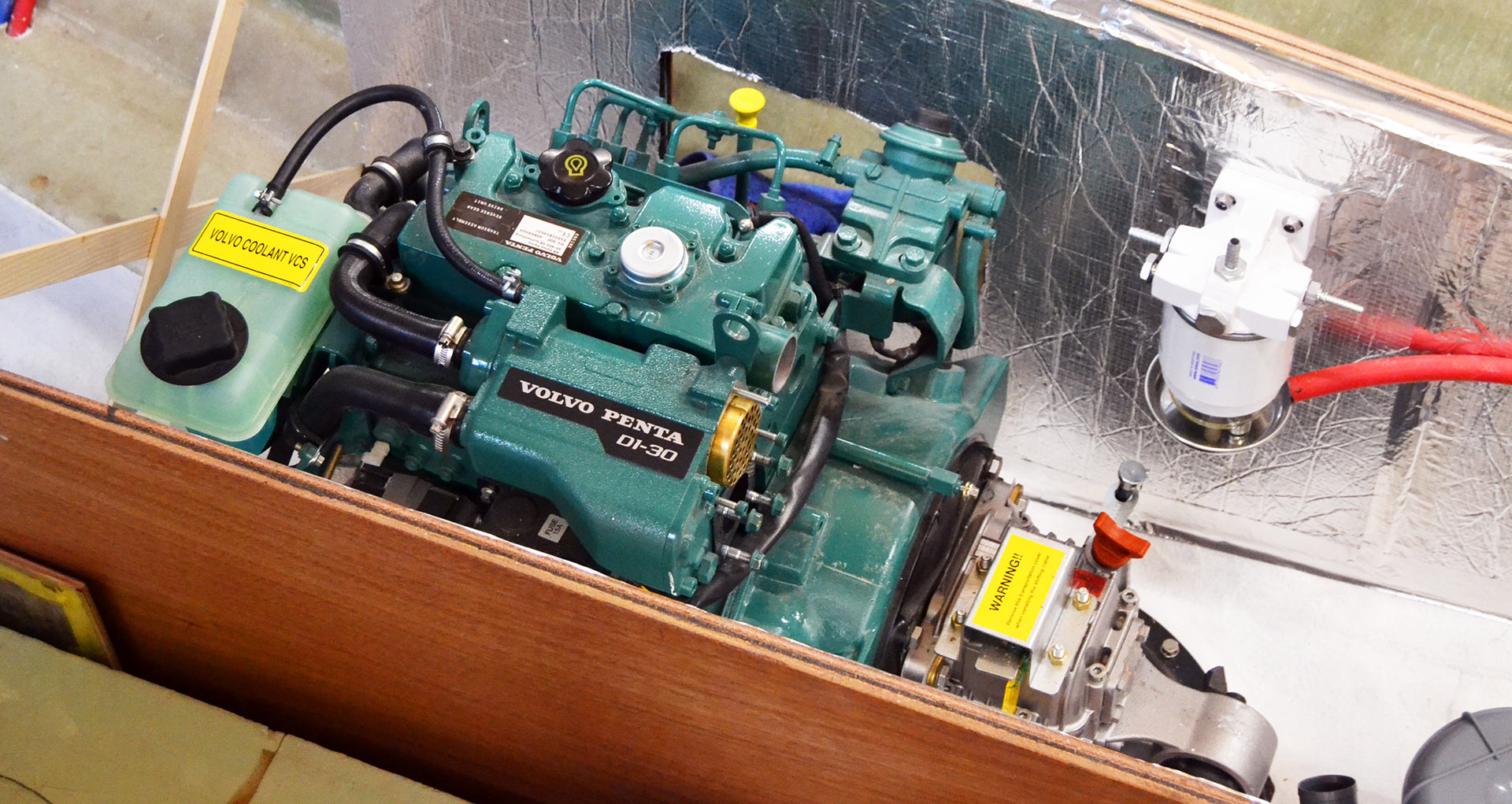
Before I enter the saloon I remain in the aft part of the boat. Of course, as the deck superstructure isn´t attached yet I cannot experience how the boat´s interior would feel like, but as I kneel down, I can imagine some of the atmosphere of the finished boat. Under the berth in the aft section the Diesel tank will be situated – now mocked by a 1:1 model from Styrofoam. I imagine the chamber-like feel of the quarter berth – really no comparison to nowaday´s yachts. On the other hand, what do you do when you come down after a watch? You just lay down to find some sleep. Who needs bulleyes?
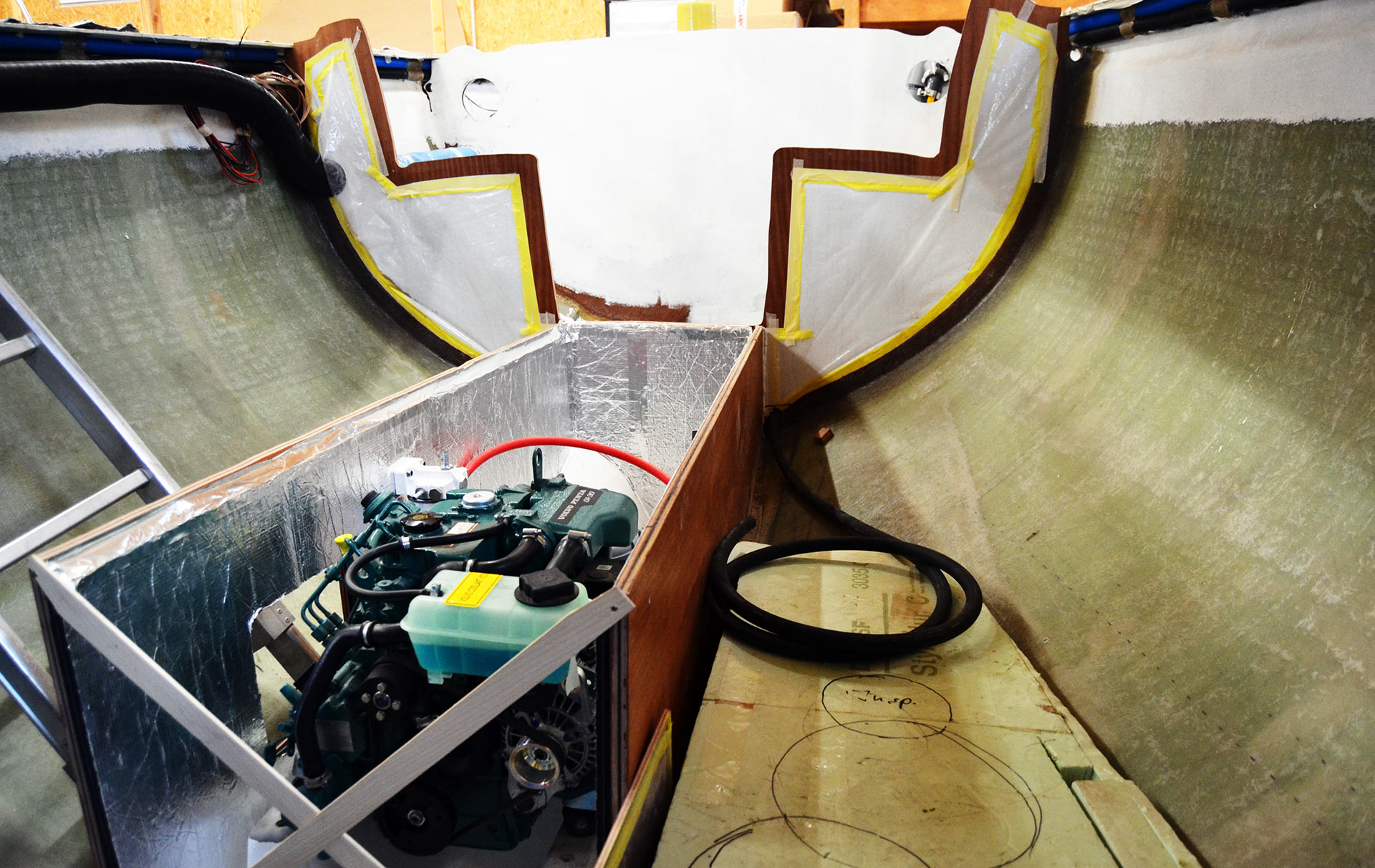
I am somewhat surprised to see that there is even some space to fit in a slim drying locker for foul weather gear. Well, of course, you easily forget that the Omega 42 indeed is a 42 foot yacht – length is not a problem here. Width and therefore volume is what is scarce here. “Standing height …”, I ask and Heiner completes my sentence: “… is in this yacht some 1.76 metres. It´s how it was back in the days.” And that´s the price you are paying to get a very, very sexy low freeboard and one of the most tempting designs in yachting history.
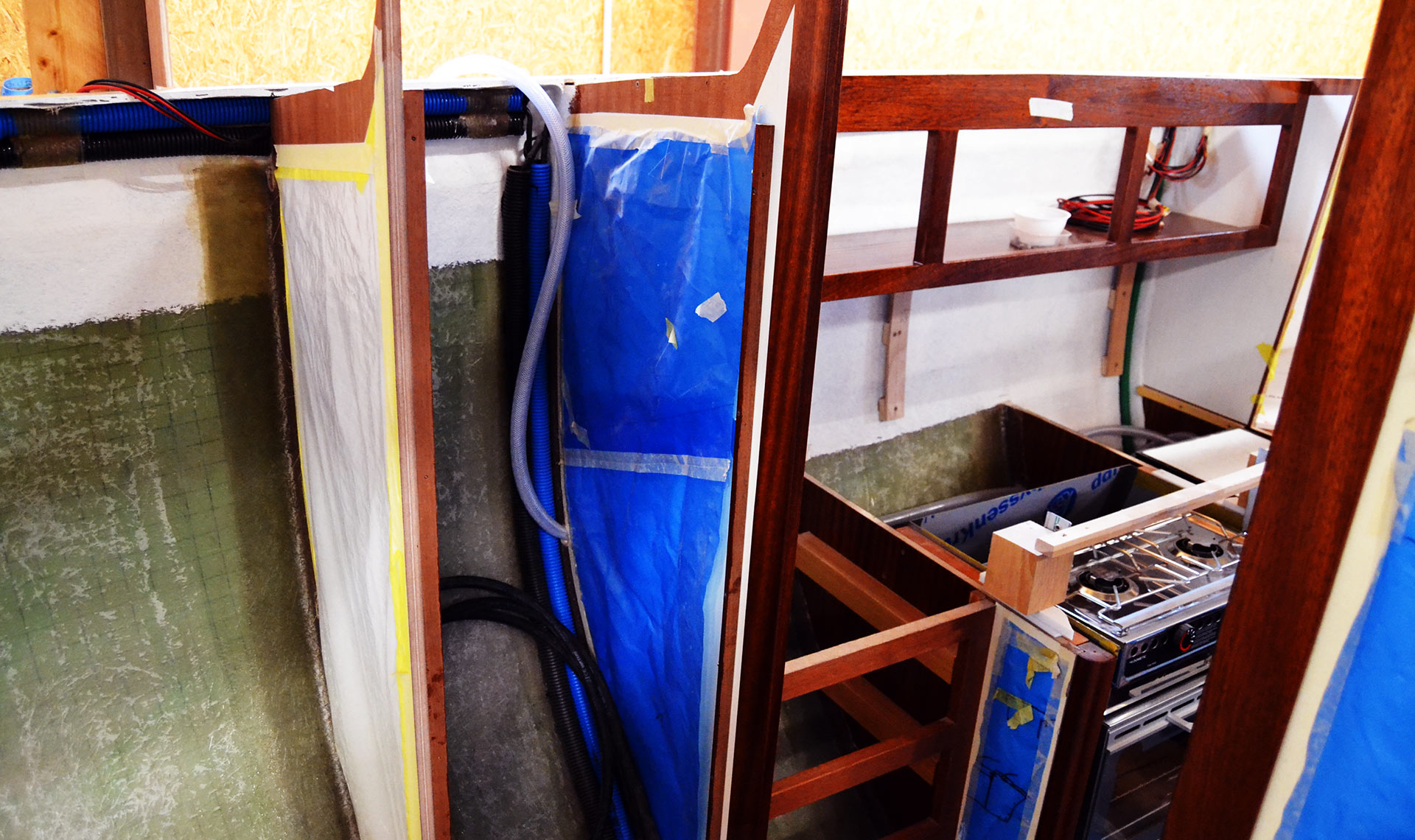
Heiner leaves no doubt that he sees the yacht as a perfect example of what sailing should be looking like: “The boat is designed to be sailed by two people easily”, he says. That´s another concession to the “new times” – in contrary to the original boat, the new Omega 42 will be fitted with a self-tacking jib. “Also thoroughly calculated and calibrated by Selden when they completely re-designed rigg and roping.” The only thing Heiner is currently not fully sure of is the fitting of a Blister sail.
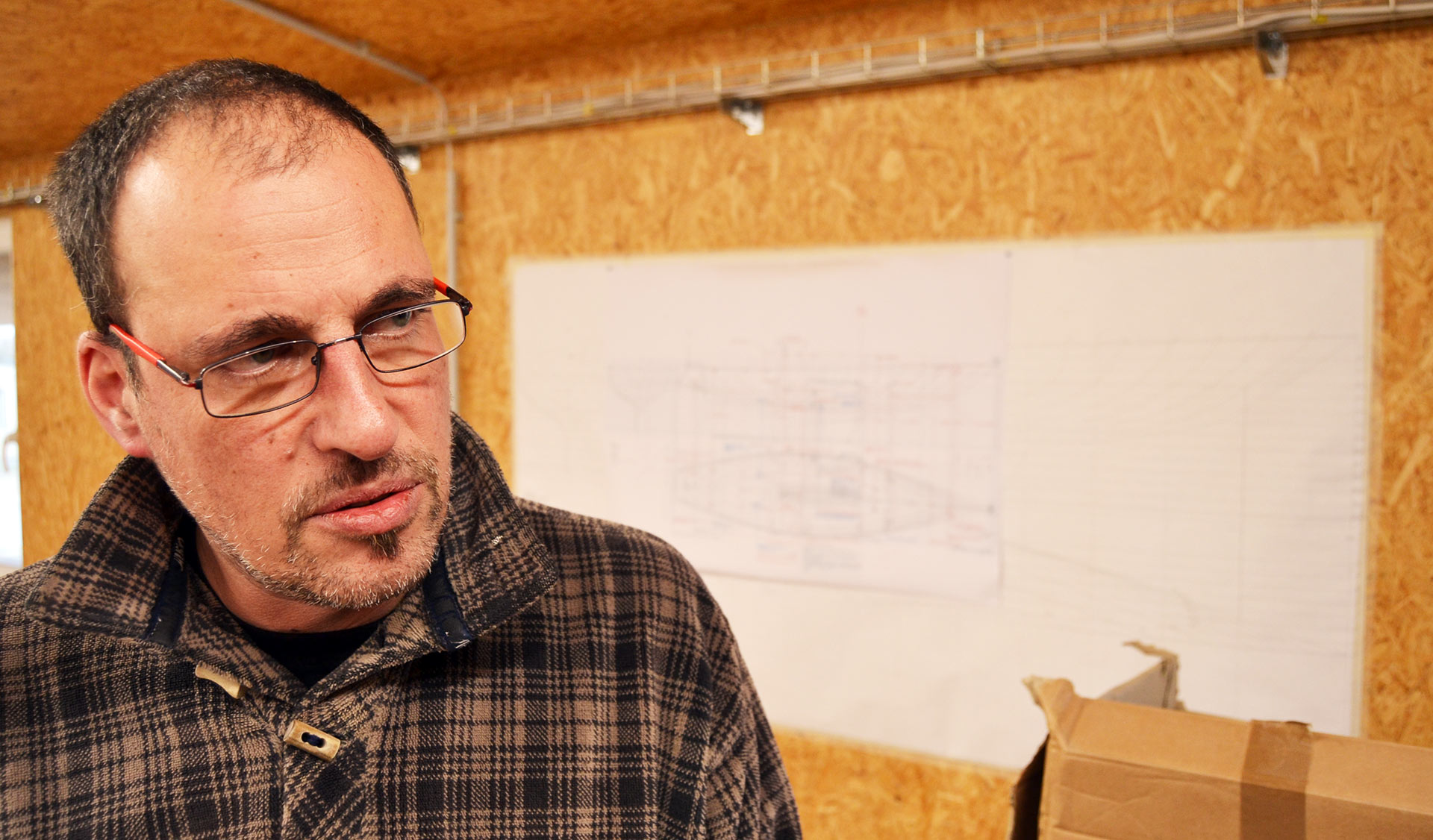
Essentially, this Omega 42 is the predecessor – or better, the role model – of the current day Danish made Faurby 42E. Measurements are nearly the same except the fact that the Faurby does indeed bear some more concessions to the present day: Just look at her bow being far more “contemporary”, not as sharp as the Omega´s and therefore providing for more interior volume. The Omega 42 will stay true to Scandinavian sailing as it once was or, how Heiner sees it: Fast, direct, no compromise.
Scandinavian Sailing Values
We enter the saloon. The internal layout of the Omega 42 is very, very sympathetic to me. First of all, there is just one single head. Then there is a galley that is fully sufficient in what you need when on the seas: Getting ready a hot meal (and not stowing hundreds of litres of Champagne in countless freezers). Then there is the saloon: Two large 3 seat settees, a folding table to dine at and a stepped mast. That´s it. Again, no bulleyes in the hull, just some windows in the deck superstructure and two hatches in the roof. Classy.
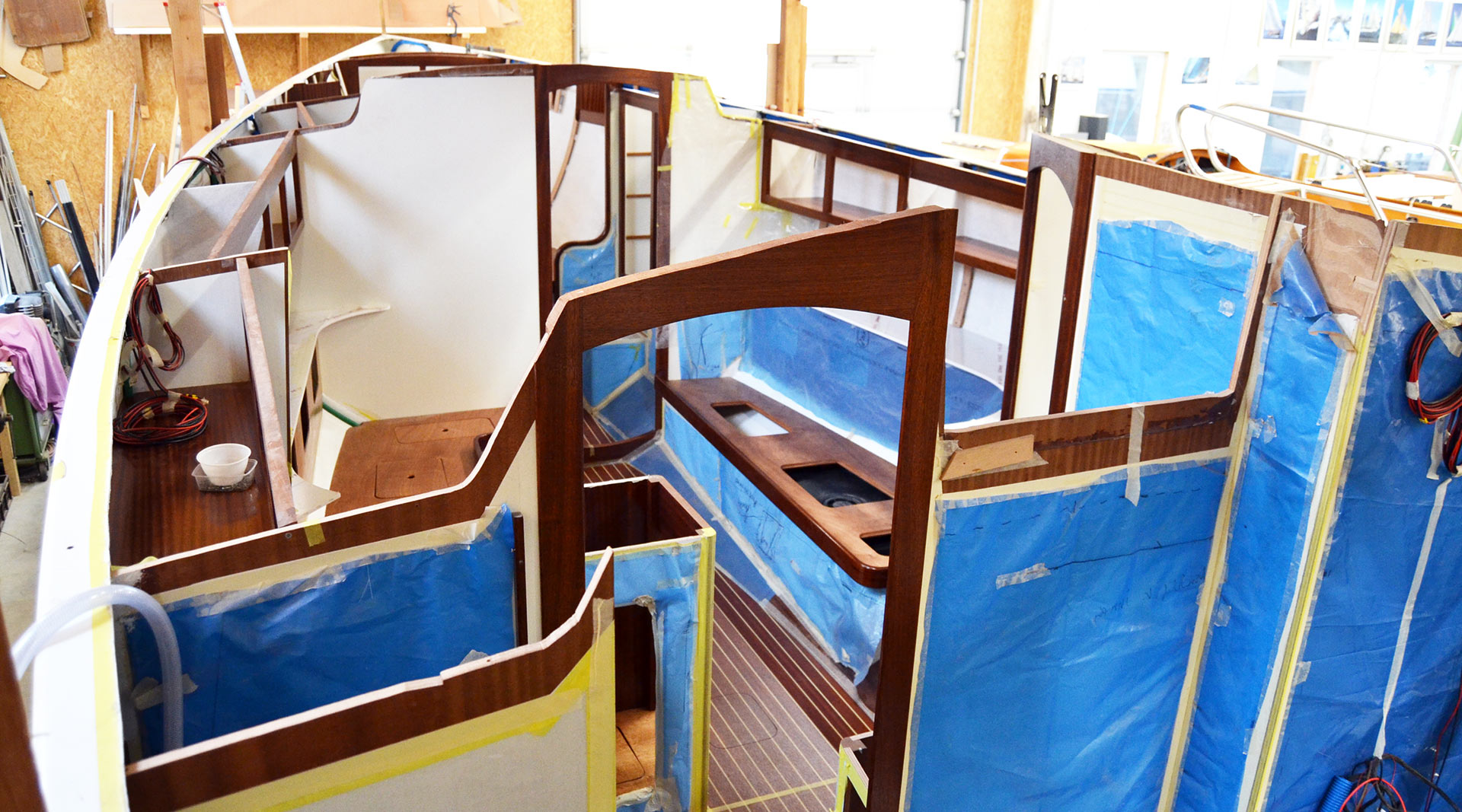
As I enter the saloon and take a closer look, I am stunned to see that all of the woodworks is done in massive timber. “Mahogany mainly”, Heiner confirms. There is some plywood to be used for some substruction, but not in the visible areas. I really like this as massive timber is something completely different in a yacht. Most of all, the saloon is done like all classic yachts: Under the seating cushion some stowage is provided, whereas under both settees the fresh water tanks are fitted.
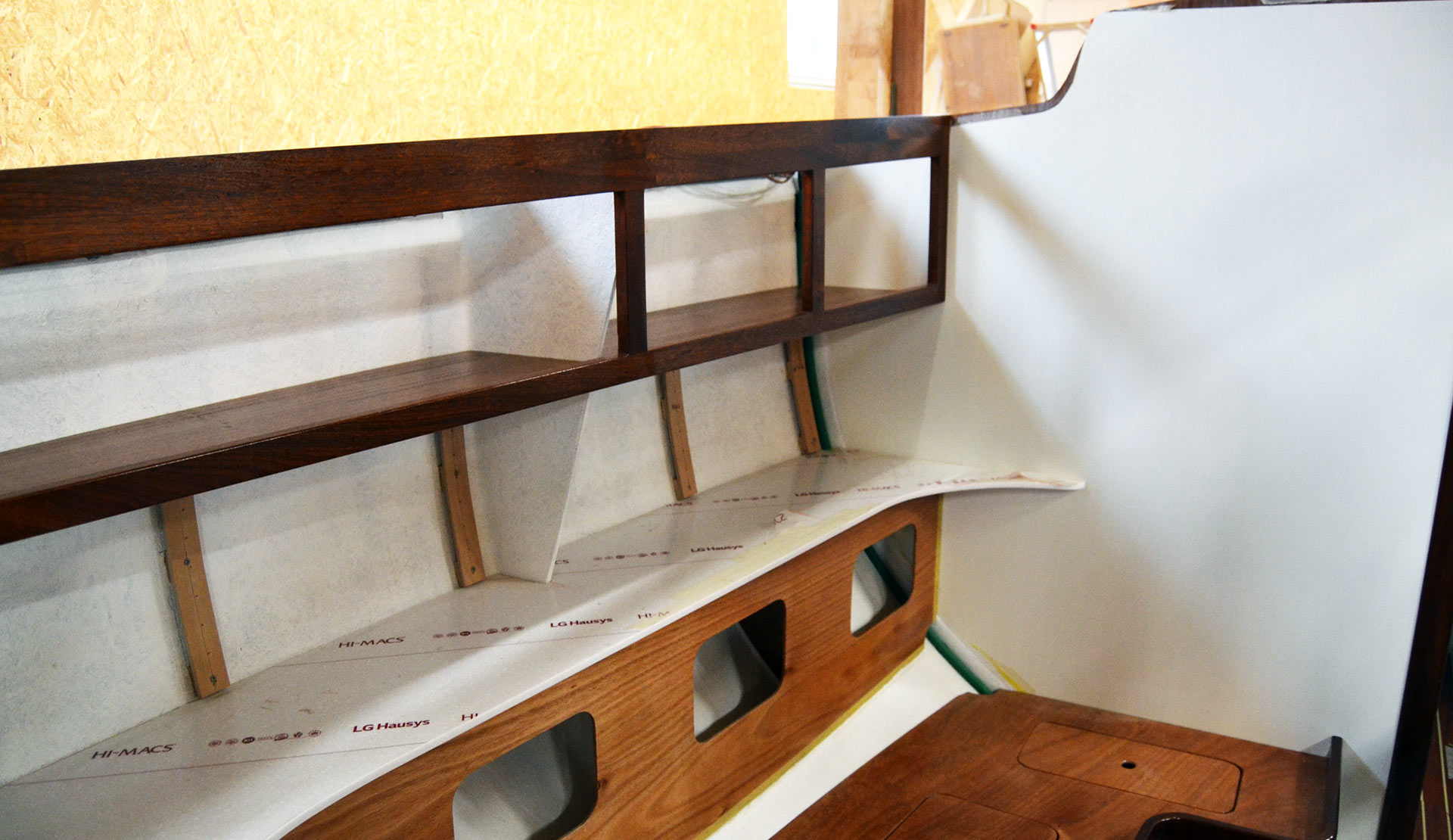
“There is technically the possibility to pump fresh water from one tank to another”, Heiner explains. Funny enough, that´s not meant to add some ballast to leeward sides when sailing (therefore the slim yacht does not a large enough angle), but as Heiner says with a smile: “I hate it when a yacht has a slight heeling upon entering harbour. For example when the Diesel tank is empty.” So, again, that´s a question of appearance.
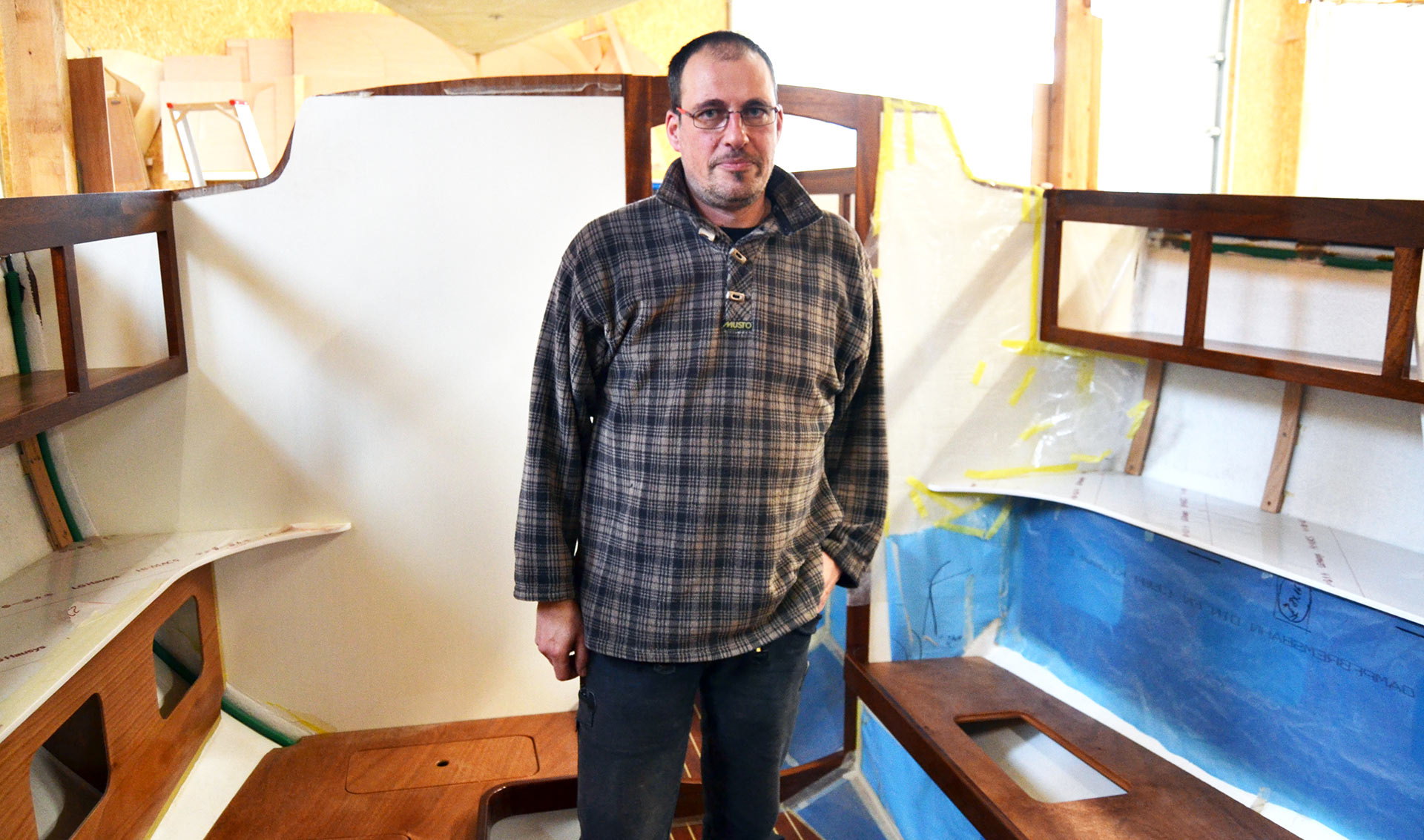
Heiner positions himself in the middle of the saloon – a way, no one will be able to do when the deck is mounted. Just as it is the case in my own yacht, standing freely will just be possible in the aft portion or the saloon. But that´s of no importance for Heiner: “Most of sailing takes place in the cockpit. You will be down here to have breakfast or dinner or just get ready for your watch. This is – again – a sailing yacht, not a maritime chillout area.”
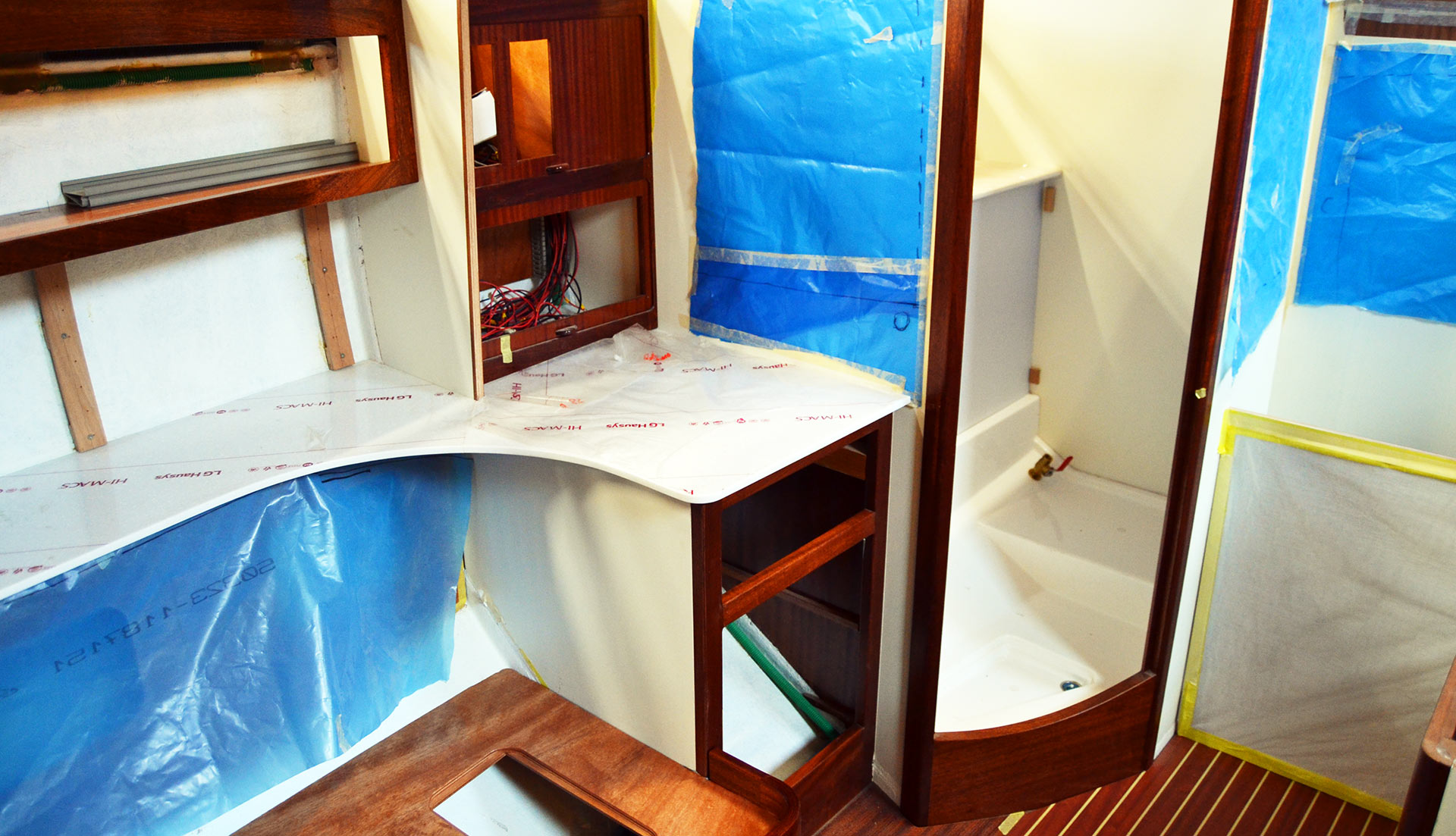
I like this concept as in its radicalness it reminds me of other sailing machines, like the Pogo or even more radical, of the Class 40 yachts – although, these are made for pure racing. The Omega 42 is a true cruiser in the sense of the word: “Reaching your destinations faster than others, also cruising in style. That´s essentially the Omega 42”, says Heiner. I enter the head and stand in surprise as this cabin is far bigger than expected.
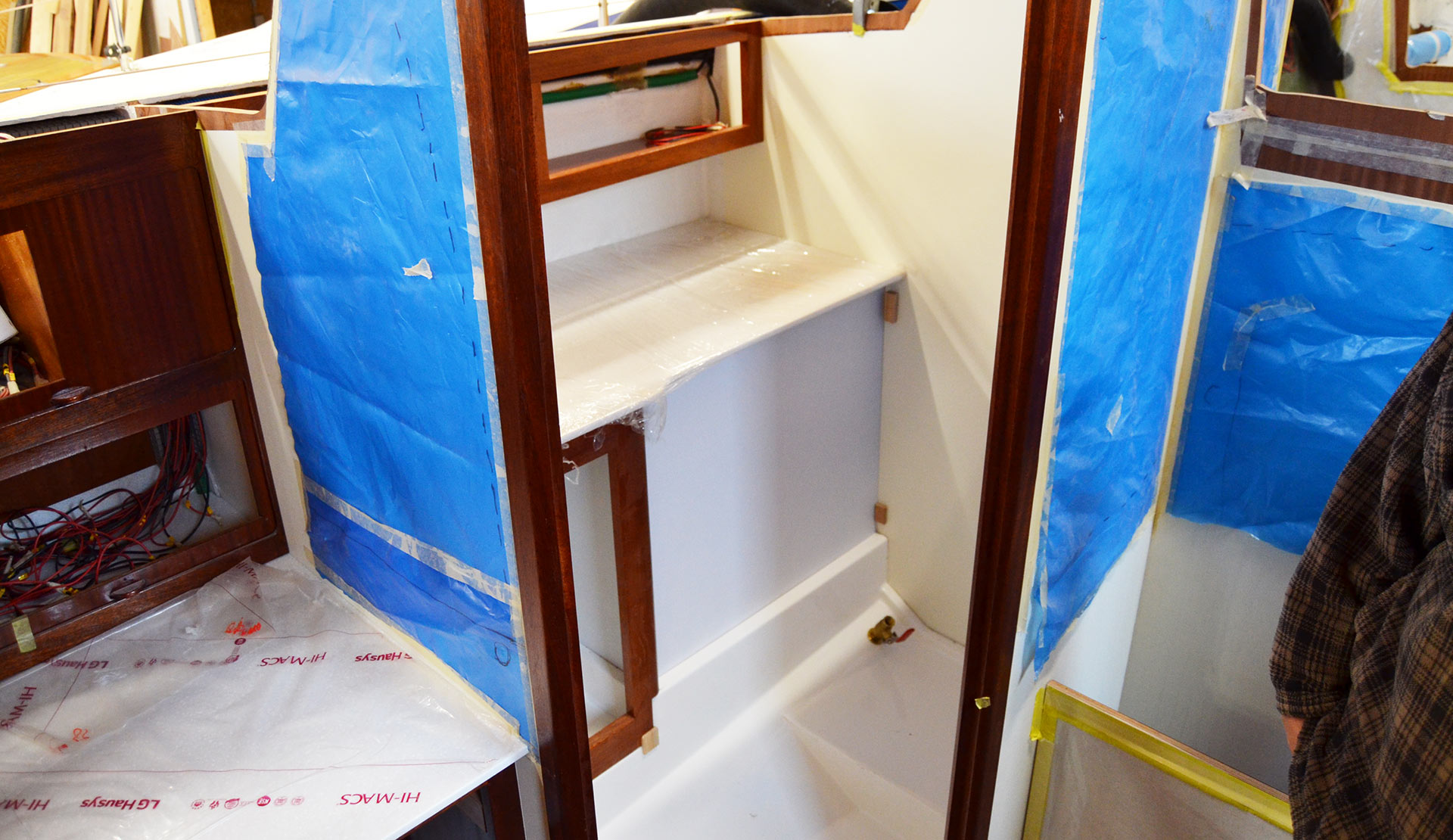
A pumping toilet will be fitted, also a small sink. Like in all of the saloon, here as well stowage in form of cupboards and sheds is provided for in countless iterations. To be honest, I have the feeling that the head of this Omega 42 is not really smaller than the one I did have on the 46 feet yacht on my Atlantic voyage. Interesting. Let´s move on to check the galley.
Scandinavian Sailing. And Cooking.
In the Omega 42 sailing yacht there will be a large L-galley, equipped with a sufficient top-loading fridge and a two-flame stove, both by market leader Dometic. But there is something different in here: “There is no gas in this boat at all.”, Heiner says. I stumble. “You see, gas is something not very common in Sweden and other Scandinavian countries. You seldom have the infrastructure in Scandinavian harbours for refilling of gas bottles.” And what´s been used instead, I ask. “Ethyl Alcohol, of course.”
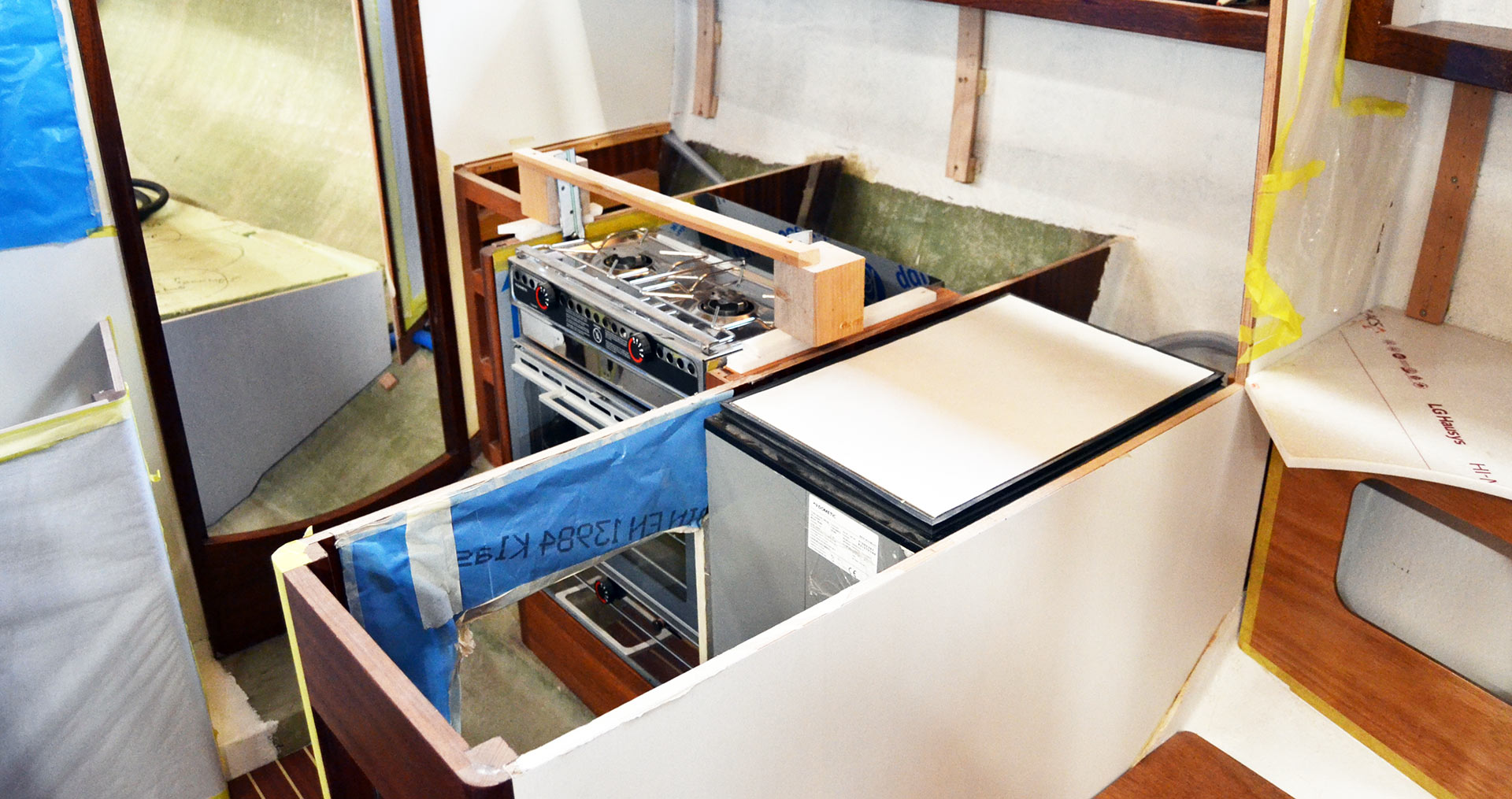
I´ve never seen a stove running on ethyl alcohol and Heiner shows me how to remove the containers. “It´s so easy, so convenient”, Heiner says: “You don´t need no gas bottles, no pressure reducers, no piping, no certifications and official acceptance of the whole circuits. Apart from the fact that it is as easy as A B and C.” This, I must admit, is totally new to me (I´ve sadly enough never sailed in Sweden) and so I just listen and see what he means. I can indeed see that using ethyl alcohol cassettes (which are resembling small versions of land mines) is an easy thing. Well, I guess that´s something for a later article.

Apart from this, the L-galley is surprisingly large for a boat so rarely offering volume. Cooking here, cutting and chopping stuff for the meals and stowing away plates, forks, knives and stuff will be no problem since there is lots of stowage next to the fridge and under the entryway. Also behind the stove and the sink and under the roof. There it is again: The full fledged cruiser concept of this yacht.
Interior building Quality at its best
Have I mentioned the utilization of massive timber mostly here? It´s far beyond that. I am not an electrician and I cannot say that I am particularly trained in yacht electrics but I gained some experience in re-wiring my own yacht in the course of my refit project – so I try to collect some information on how they did it in the Omega 42. And they did it so well, indeed!
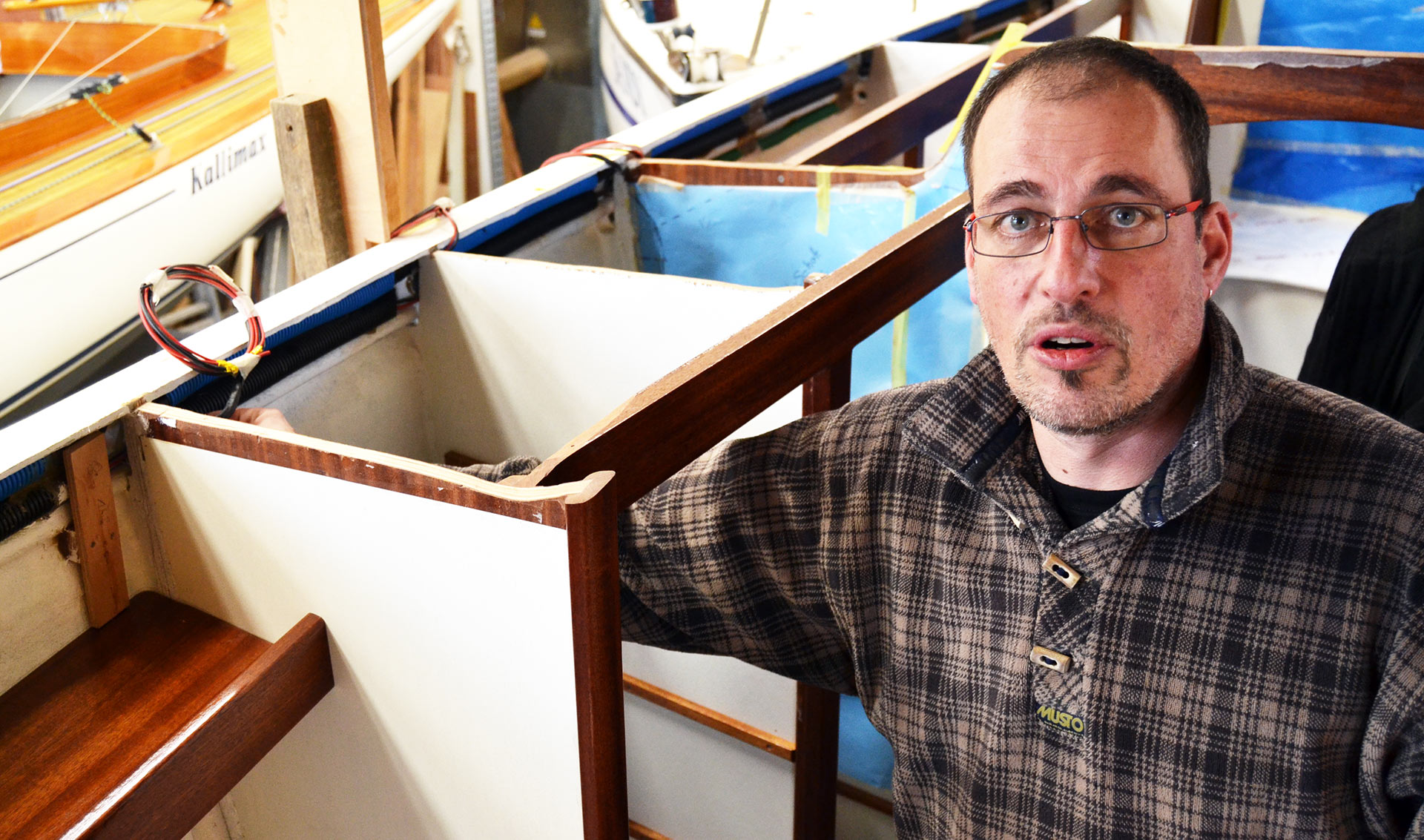
“All wires are running in large diameter self-guiding pipes.”, he explains. There is a black and a blue one running down the whole length of the yacht. “One is housing all wires for the 230 Volt circuit, the other for the 12 Volt current consumers.” Also, where cables are bent, the team strengthened the wires with multiple layers of thick Gaffa, preventing chafing. “That´s also a check point in the CE certification process”, Heiner says. One of the two CE-checks had already been passed by the team and the boat.
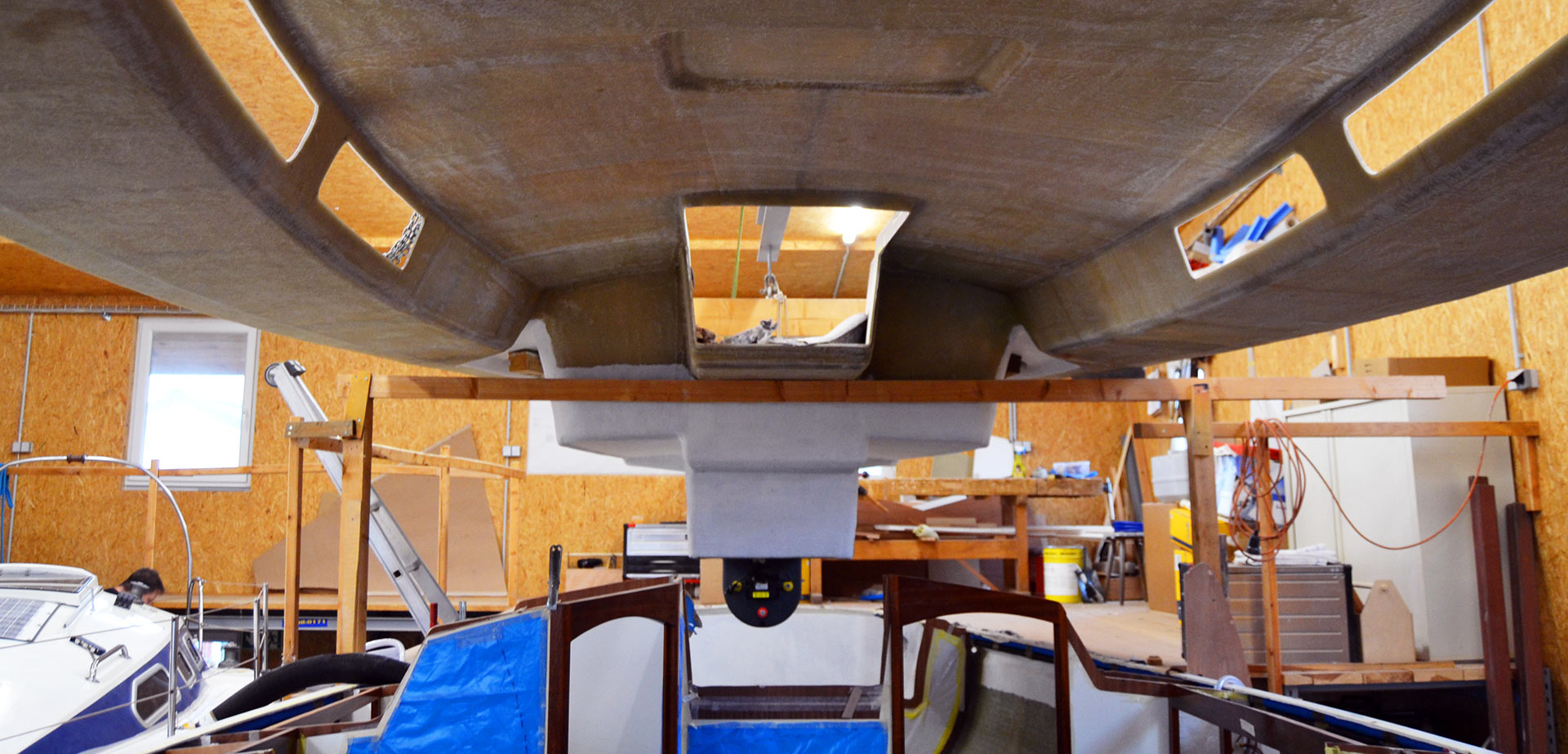
This CE certification process is necessary in order to get permission to sell this boat. It´s a process of weeks if not months. A two-step procedure: A representative of this commission, in the case of the Omega 42 it´s a Dane, is crawling through every single plan of the boat and will inspect the hull in a certain state of build. “He is then checking for all of the things and will announce what is good, what can be done better and – in some cases – what must be change in order to meet the requirements.”, Heiner explains. “Depending on the amount and scope of these changes, the whole process can take weeks or months – and thus have an impact on both schedule and costs.” Second and last examination will be when the boat hits water – and this, how Heiner tells me – expected around May 2018.
Visiting the Owner´s Cabin in the OMEGA 42
I work my way further to the bow. Now that´s pretty easy since there is neither the large folding table mounted not the mast stepped. Through a door one would pass the main bulkhead and enter the fore cabin. Here, even though the boat may be a slim yacht, the 42 foot can be seen clearly and compared to my King´s Cruiser there´s much more space available.
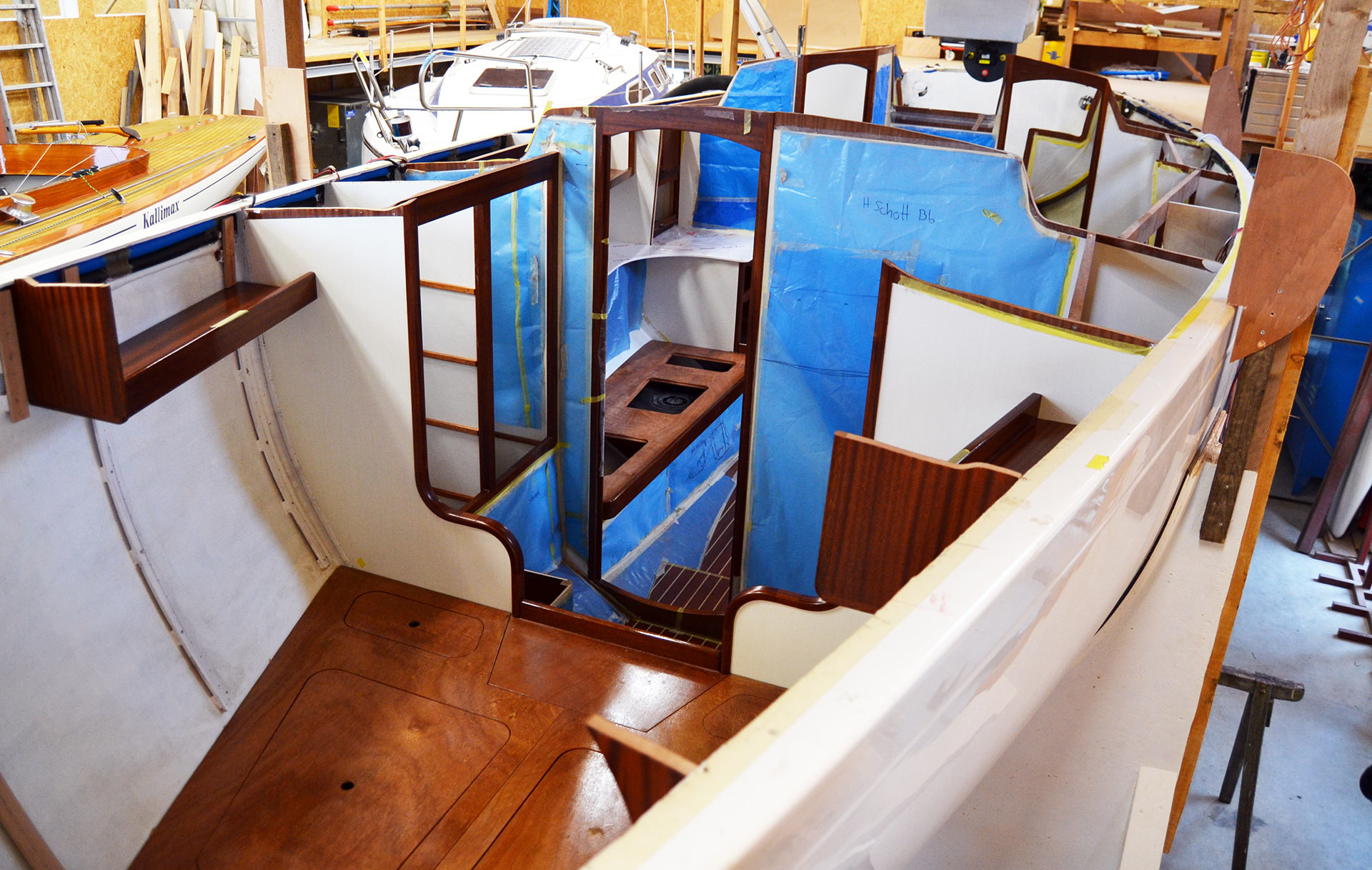
Upon entering the fore cabin there are two large lockers to either sides of the boat. Also, one large and one smaller stools are placed here which will make it far easier for the owners to get dressed and undressed, especially when the boat is rocking in heavy weather. Again, all woodworks are done in massive Mahogany which will be varnished silk mat. Of course, the front cabin features classic V-berths.
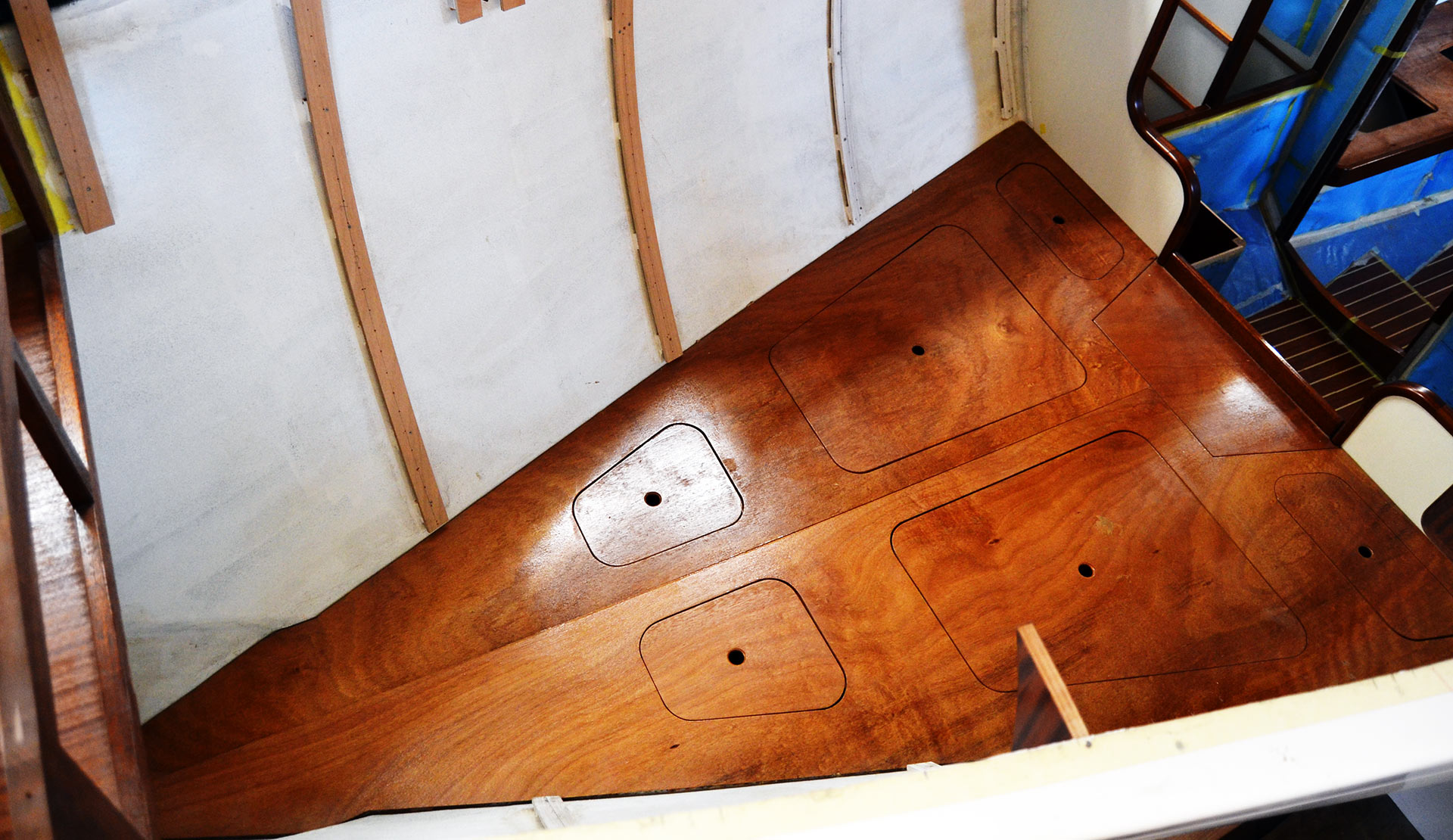
Testing the space, there won´t be any problems for two adults to snug in here and find a good night´s sleep. More than 2 metres in length and even at the front end still sufficiently wide there won´t be any trouble – in contrast to my own boat where I highly doubt that two adults can sleep without their feet “fighting” for space.
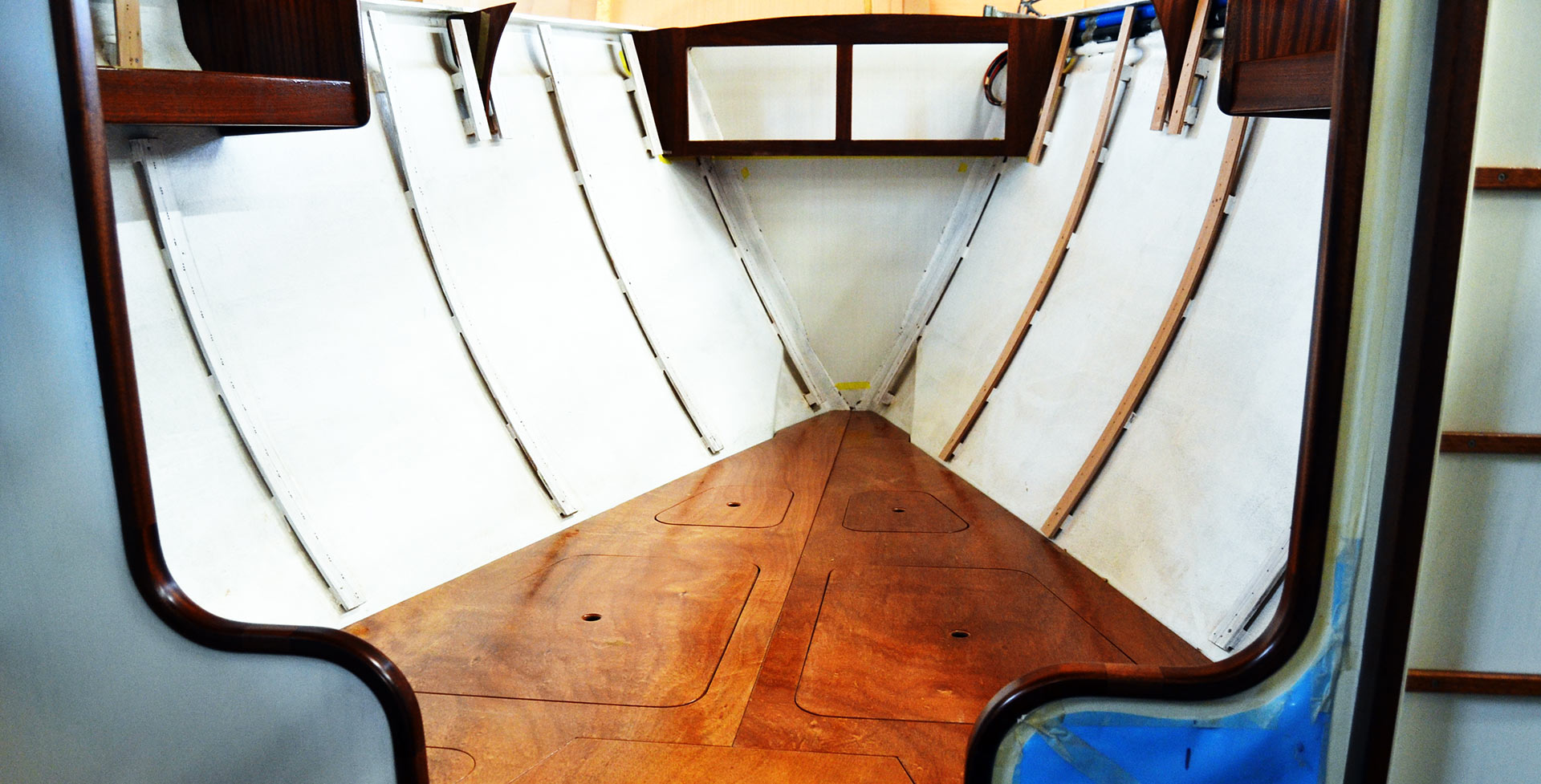
You may have read my post on the fore cabin refit when I was making some shelves to be mounted all along the whole cabin? Read it here if not. That´s different in OMEGA´s fore cabin: There is a large cupboard right at the collision-bulkhead to the chain locker and two similar sized ones next to the entrance – just all along the berths won´t be any shelves, just pure ceiling.
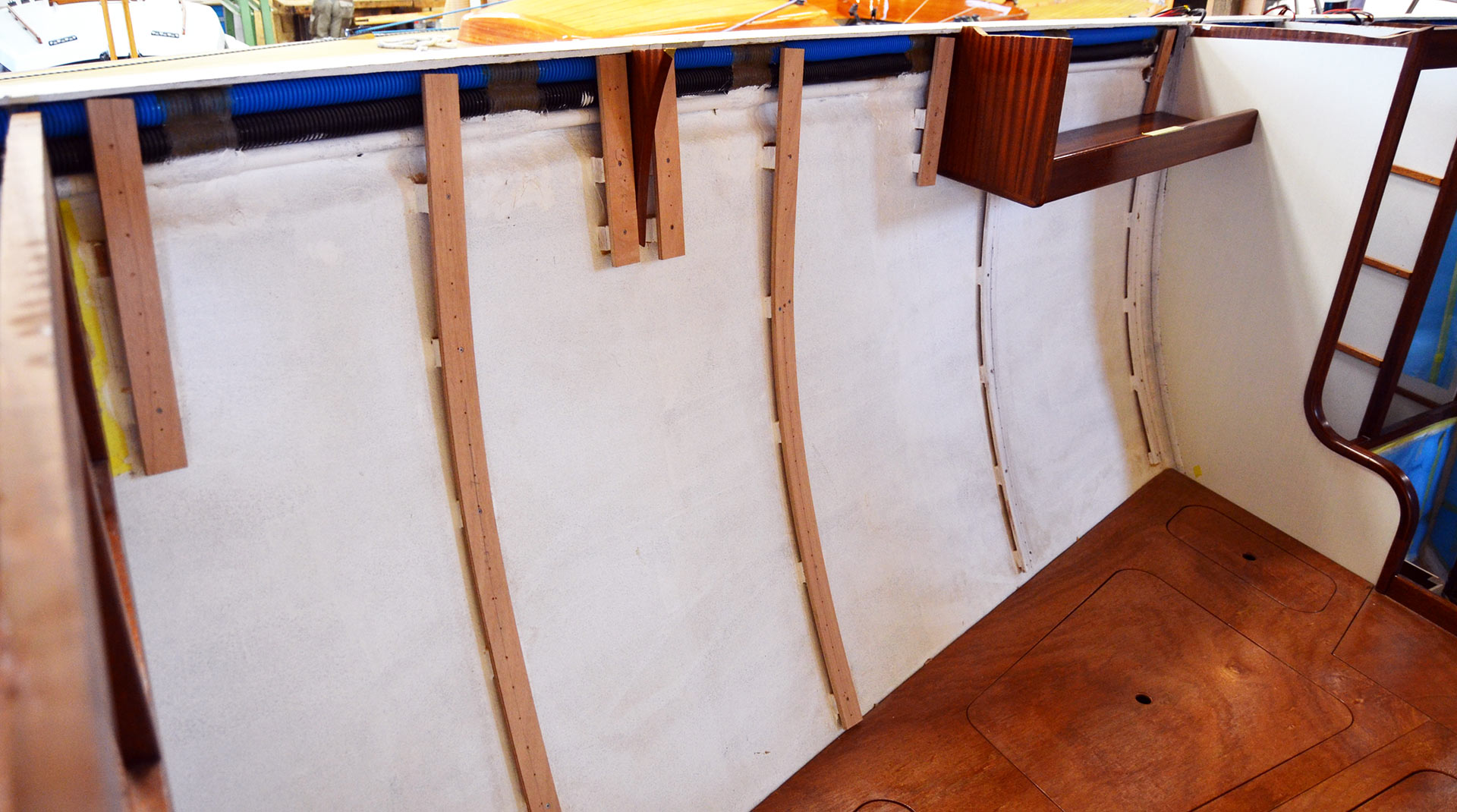
Speaking of which it made me instantly smiling when I saw that professional boat builders seem to make the ceiling the same way I figured it our for my King´s Cruiser. There´s also a substruction where the ceiling batten will be screwed to. Heiner tells me that they will use Larch timber here which will be varnished silk-mat white: “For all white varnished wooden surfaces we will use an especially developed paint.”, he adds.
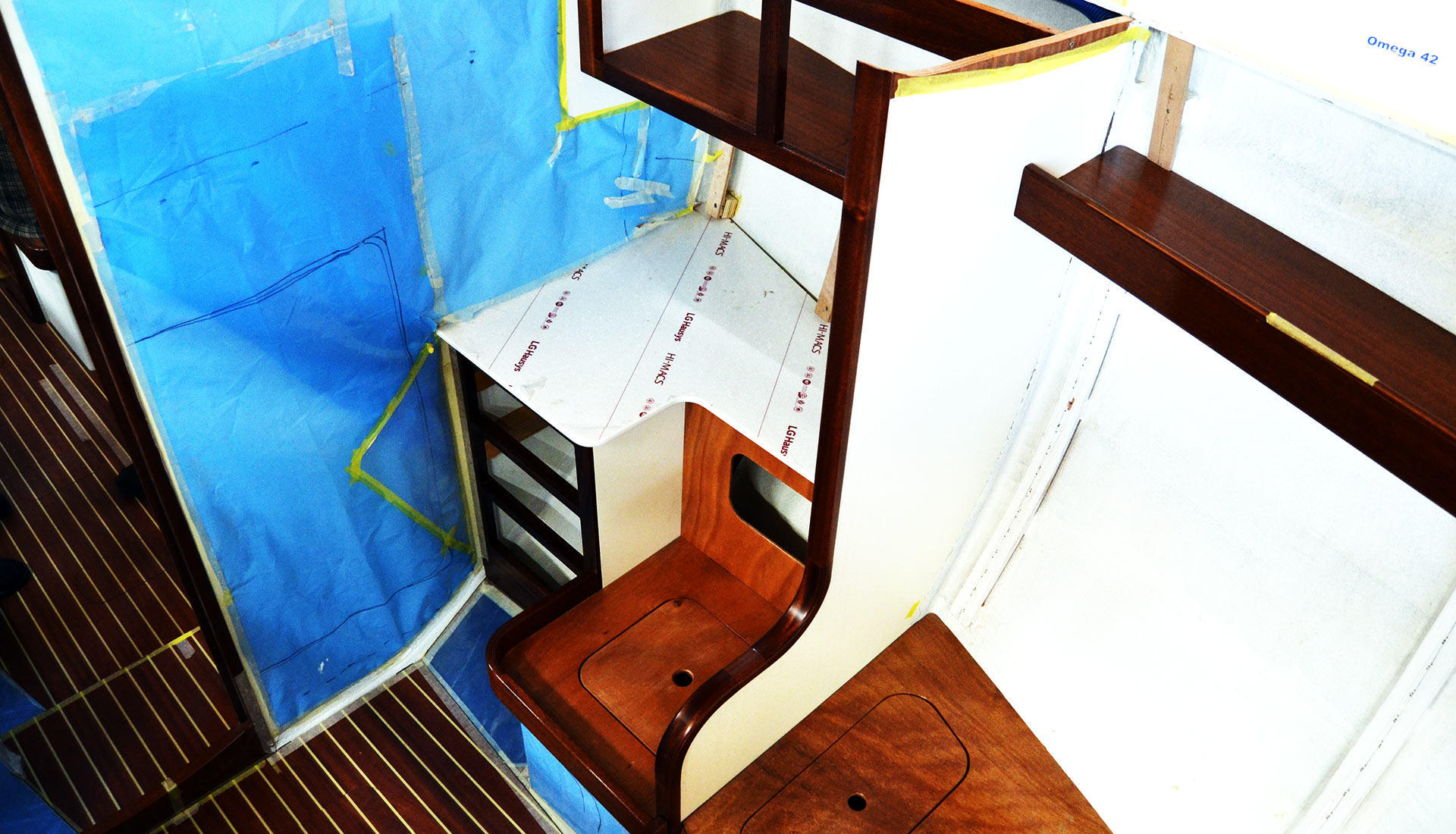
There will also be an emergency escape hatch in the fore cabin here – thus the only source of natural light. If there are some points of critique – if there are any – this would be one of them: The boat will be a dark one compared to what nowadays is possible with saloons and cabins being light suffused by skylights and alike. But, you guessed it by now, that´s staying true to the original intent of Peter Norlin´s vision in making a perfect sailing vessel.
Swedish Tradition and German Craftsmanship
An exciting walkthrough draws to an end. Exciting even if the boat is far from finished. The quality of the build is exemplary. One can clearly see that professional craftsmen with lots of passion are giving their best to create this marvel. Heiner tells me that they are now some weeks behind schedule. But that´s nothing new to me – hull #1 is always and adventure, even for the big names in the business. Especially with this boat where no plan at all was available. I wonder how they´ve made it to get all those panels fitting without any clearance. Amazing!
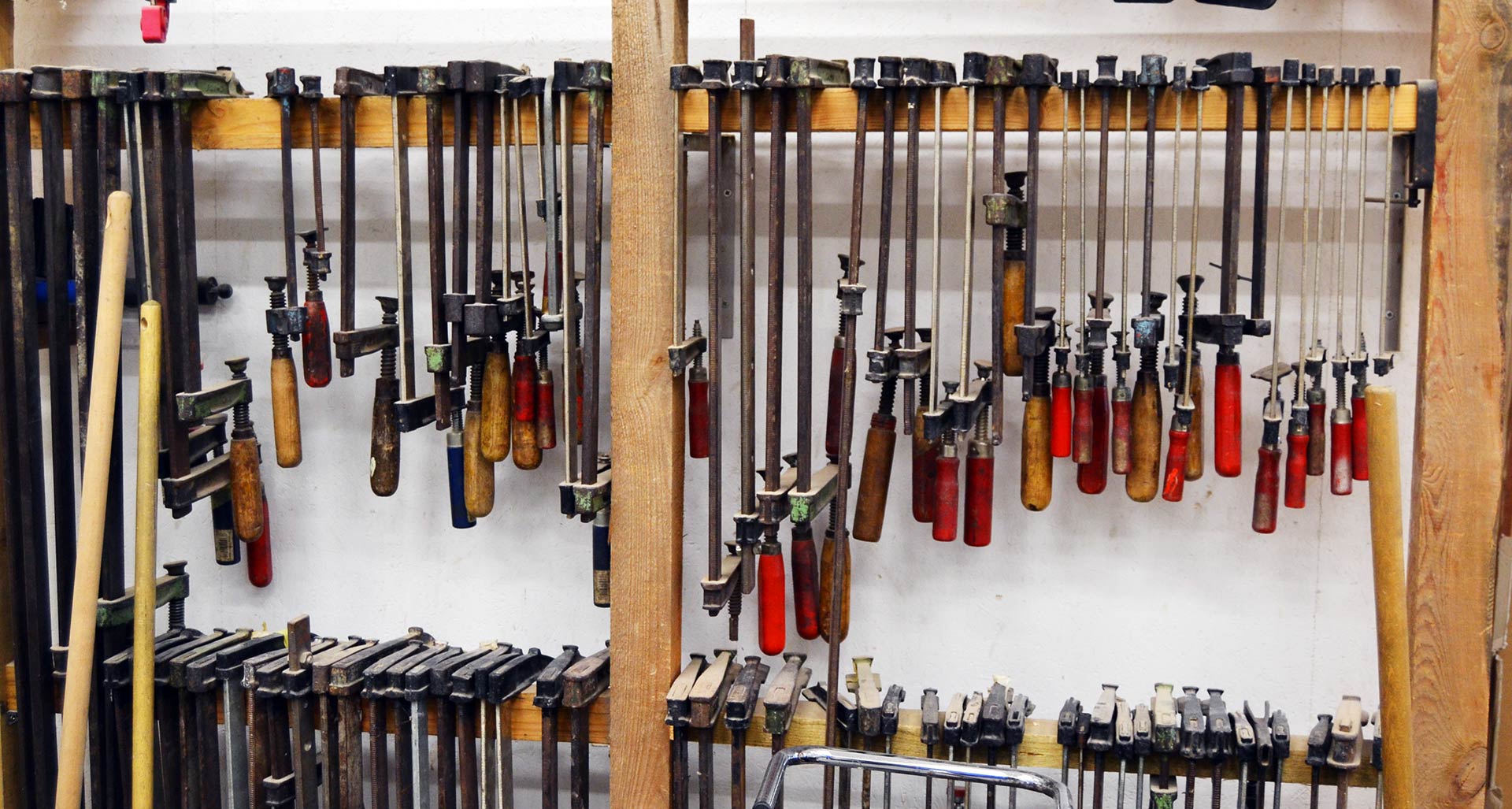
All in all this is one of the most exciting boats I´ve seen in months. Heiner and his crew are really making Peter Norlin´s vision come true without sacrificing anything to modern times nor to the demands of “the market”. “Boat one was sold back at the very day when we were doing our race and came up with the idea of re-creating Omega 42”, says Heiner. Another boat had been sold right after the project´s website went live. “The interesting part is that we are getting a constant stream of E-mails from people interested in our project.” Heiner doesn´t seem to be much worried if a Seventies boat can sell well in 2018: “I do not have to make my living from it”, Heiner says and exhibits the calmness and confidence one probably needs when starting such a venture.
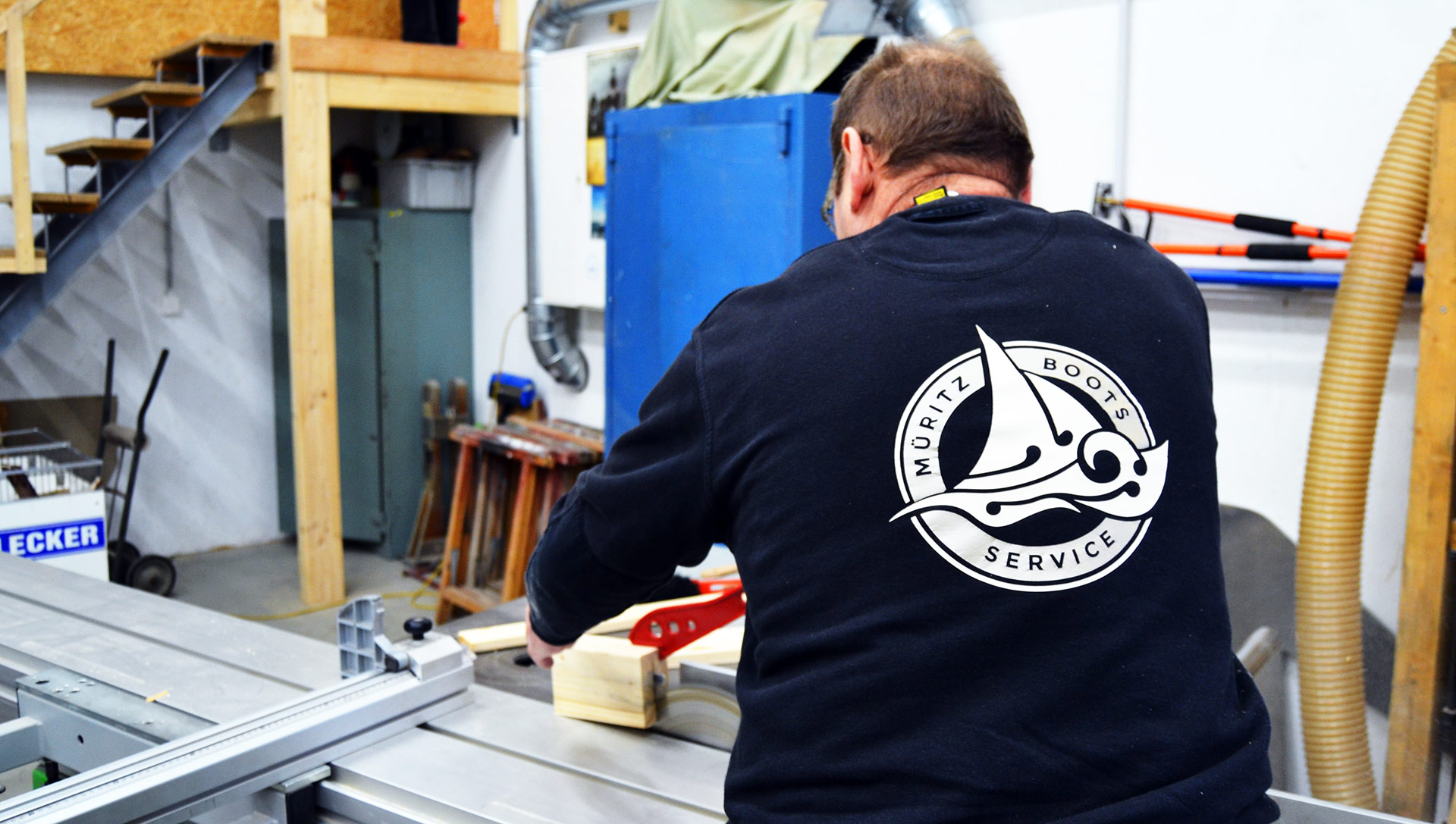
There are some things I do not like about the Omega 42, I must admit. The absence of a proper chart table is something I would put on such a list. I´m also not a fan of the stony surface they´ve fitted in saloon and fore cabin (but that´s something any owner can decide freely by his own). Adding some skylights in saloon and fore cabin as well as maybe widen the existing portholes would bring more natural light into the boat – and would not compromise the character (especially the sailing characteristics) of the boat. All in all these are minor things – compared to another list that is full of admiration for the timeless lines and the look of this elegant, sleek and classy yacht.
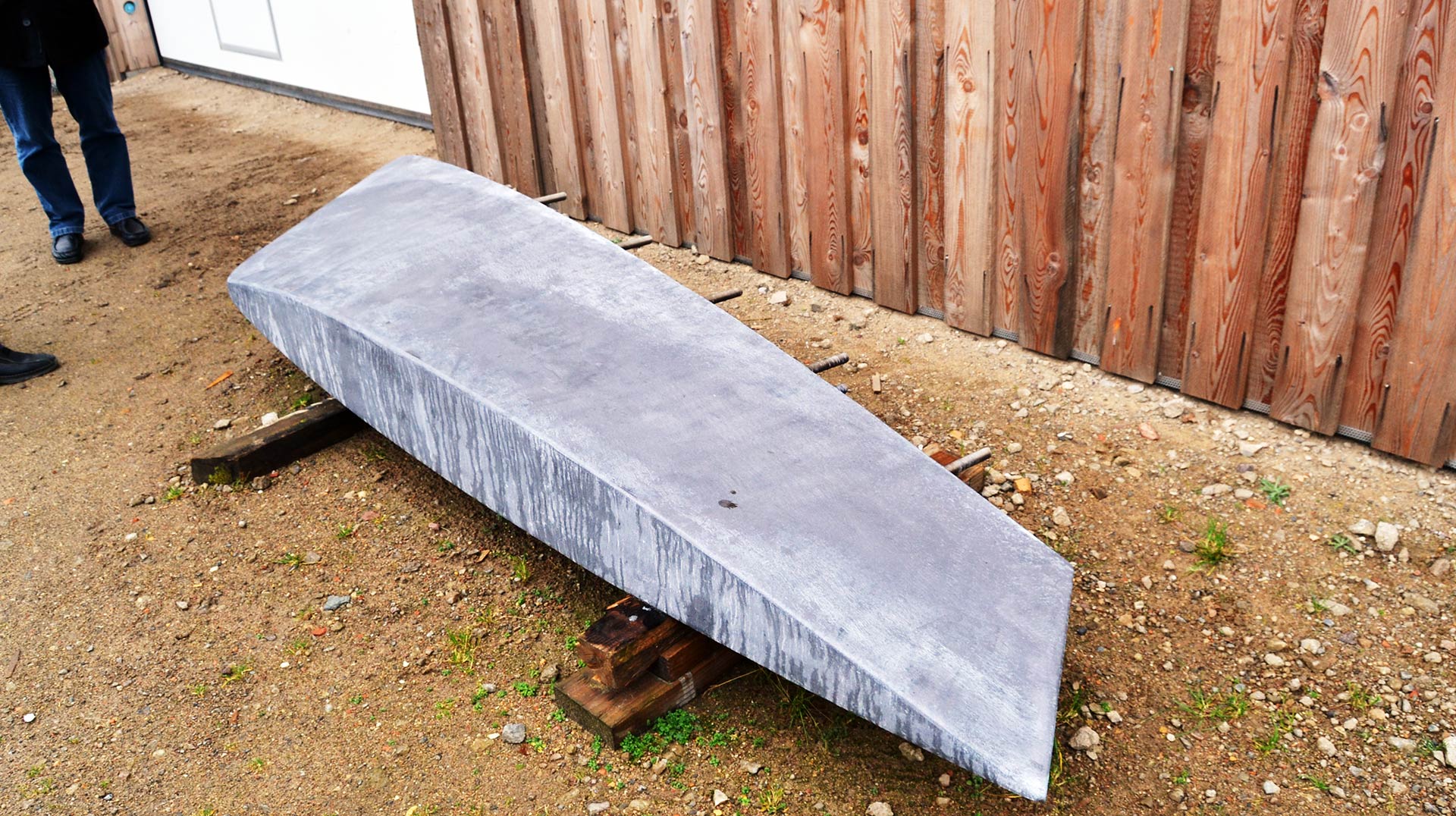
Outside of the shop the keel is stored. 3.75 tons of pure lead, made by one of the last remaining lead foundries of Europe (maybe in the world). This alone is another exciting story to tell. I found it interesting that a boat like this has more than 50 per cent of ballast in the keel – but the Omega 42 has a draft of just 1.67 metres. That´s very, very shallow. Nevertheless, more than enough to keep her up and safe. “When she sails, she will be perfectly stable even with 35 degrees heeling angle. She will remain steady in this position and lift off like nothing”, Heiner is swarming.
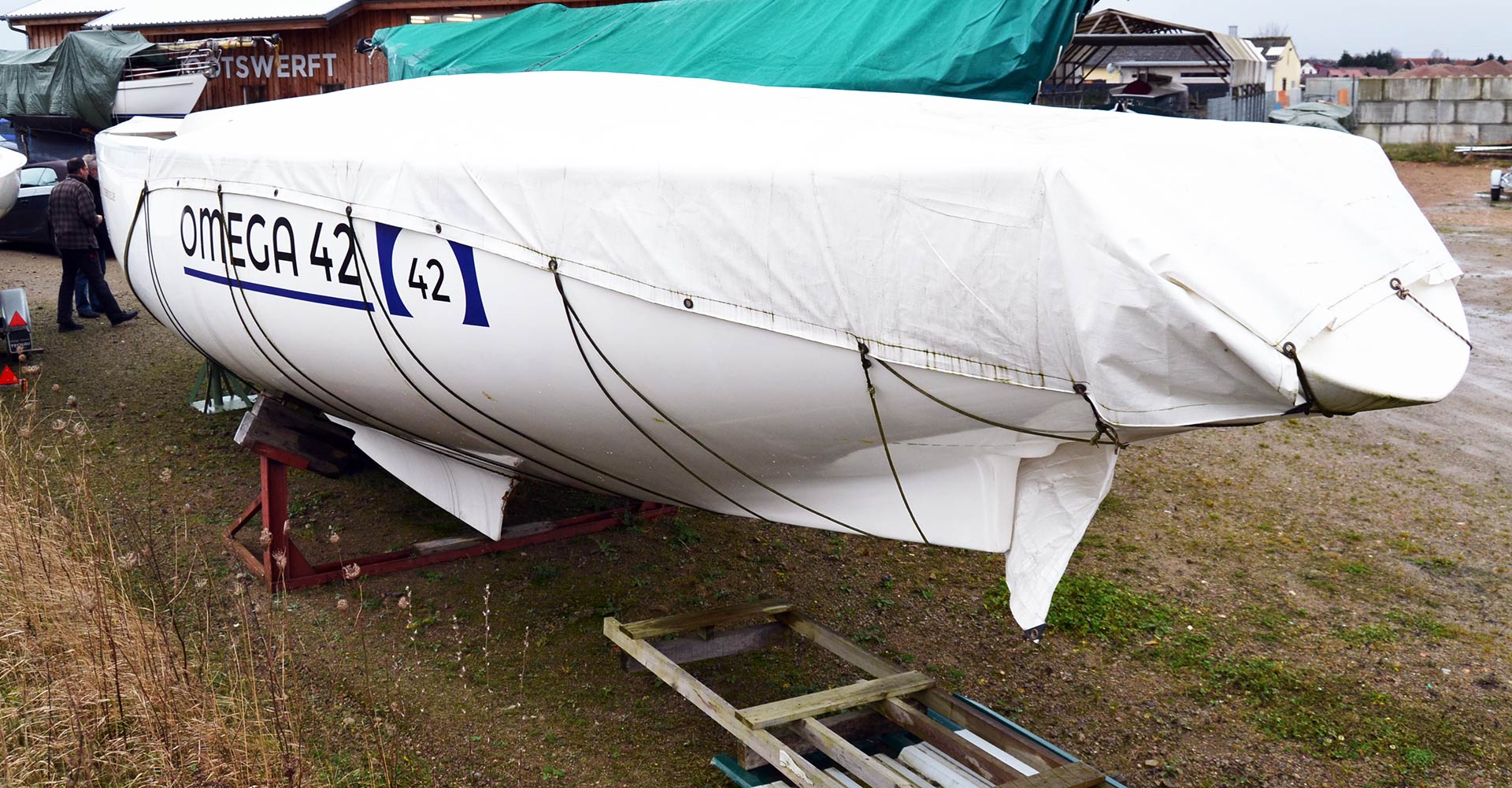
Will this extravagant, exciting, anachronistic, aggressive, fast, speed-loving, no-compromise yacht find her owners? I bet she will! I guess there are some sailors out there who are seeking the special, who are seeking the thrill and are willing to be walking off the path. When we part and say Goodbye, I am still stunned by the enthusiasm of the team, by their unbreakable belief in what they are doing and the degree of obsession in re-creating the legendary Omega 42. It will surely be a feast of sailing when this beauty will finally hit the water.
And, to be honest, I can´t wait to see her under canvas – Peter Norlin would be proud of their work. As well as lucky owner of hull #2 which is parked outside. She is sold already.
You might also be interested in these similar articles:
German dream yachts made in Emden: BERCKEMEYER Aluminium sailing boats
Performance Cruisers made of Epoxy & Plywood: RM Yachts of La Rochelle
ARCONA Yachts of Sweden: Dear Santa …
